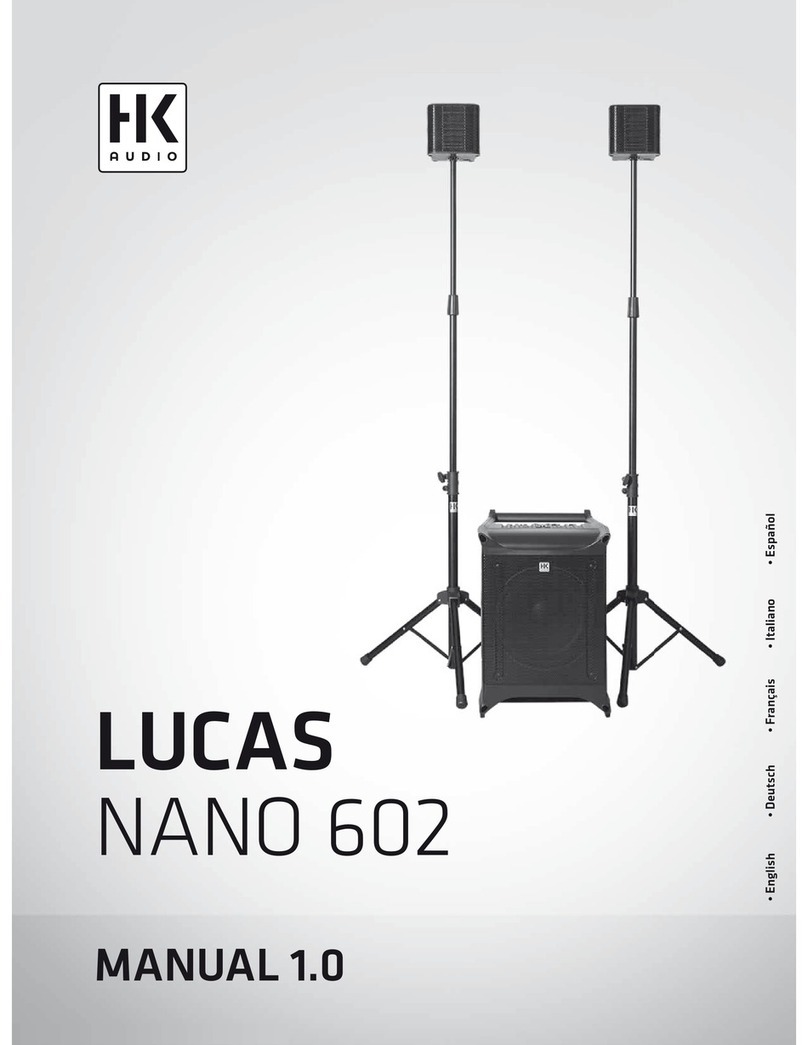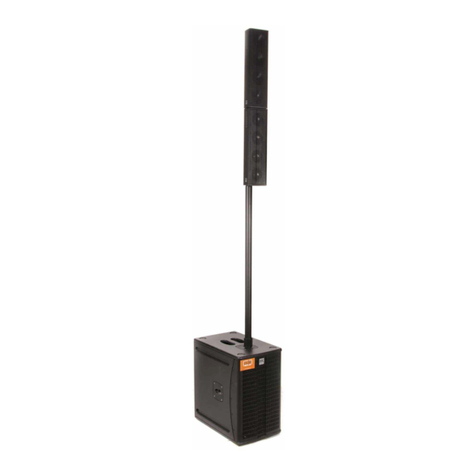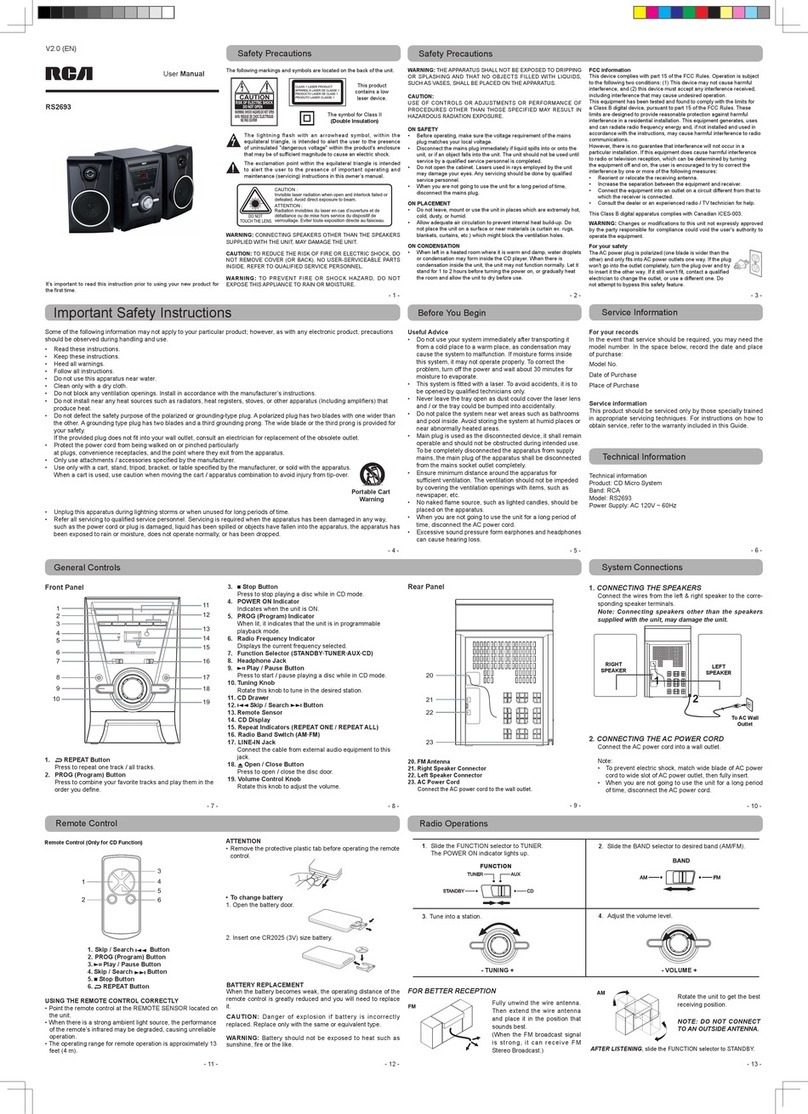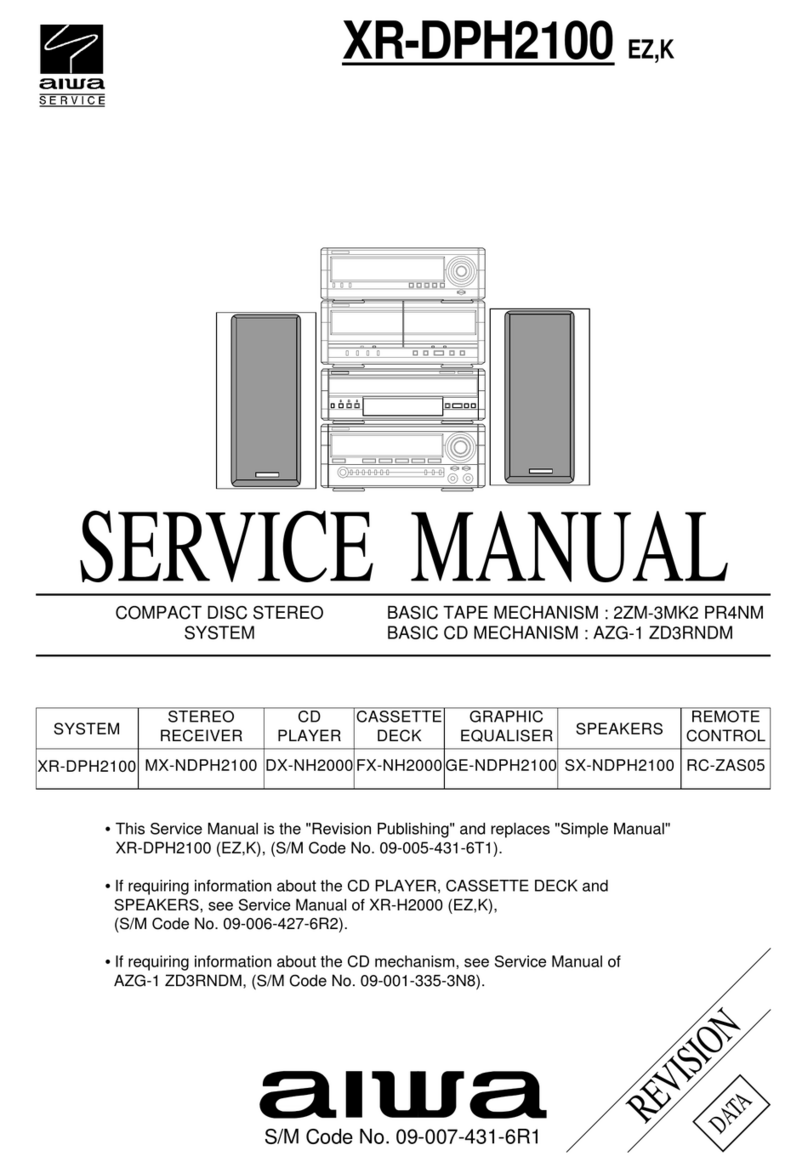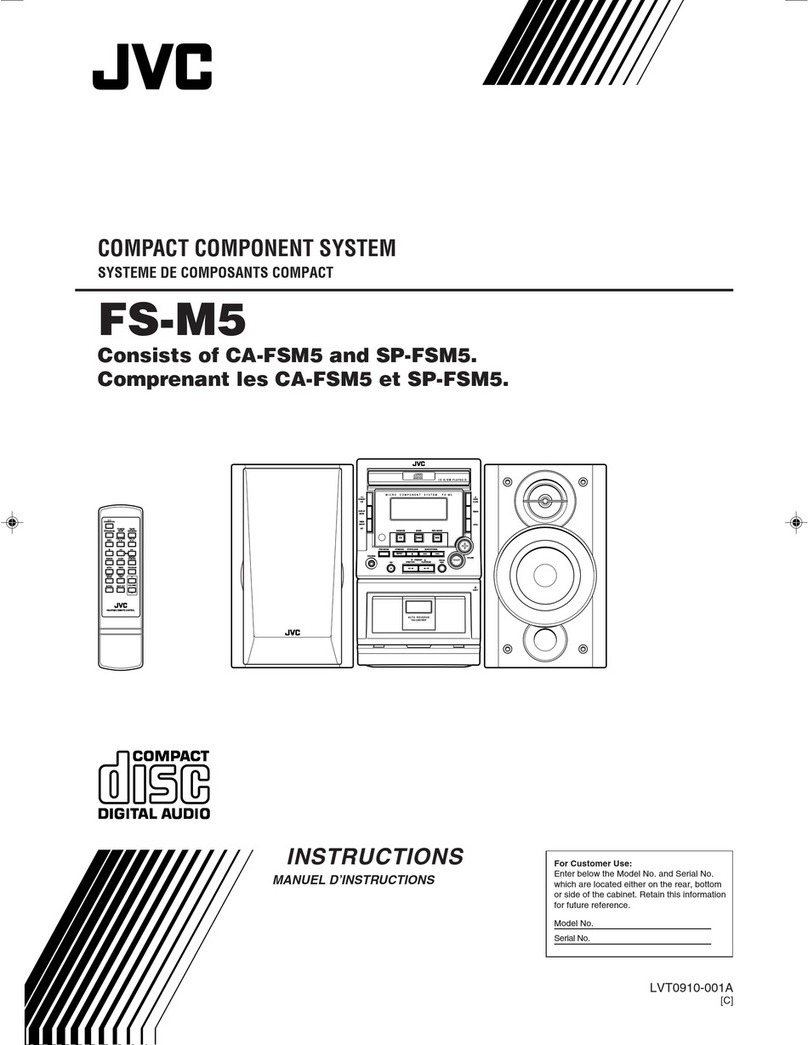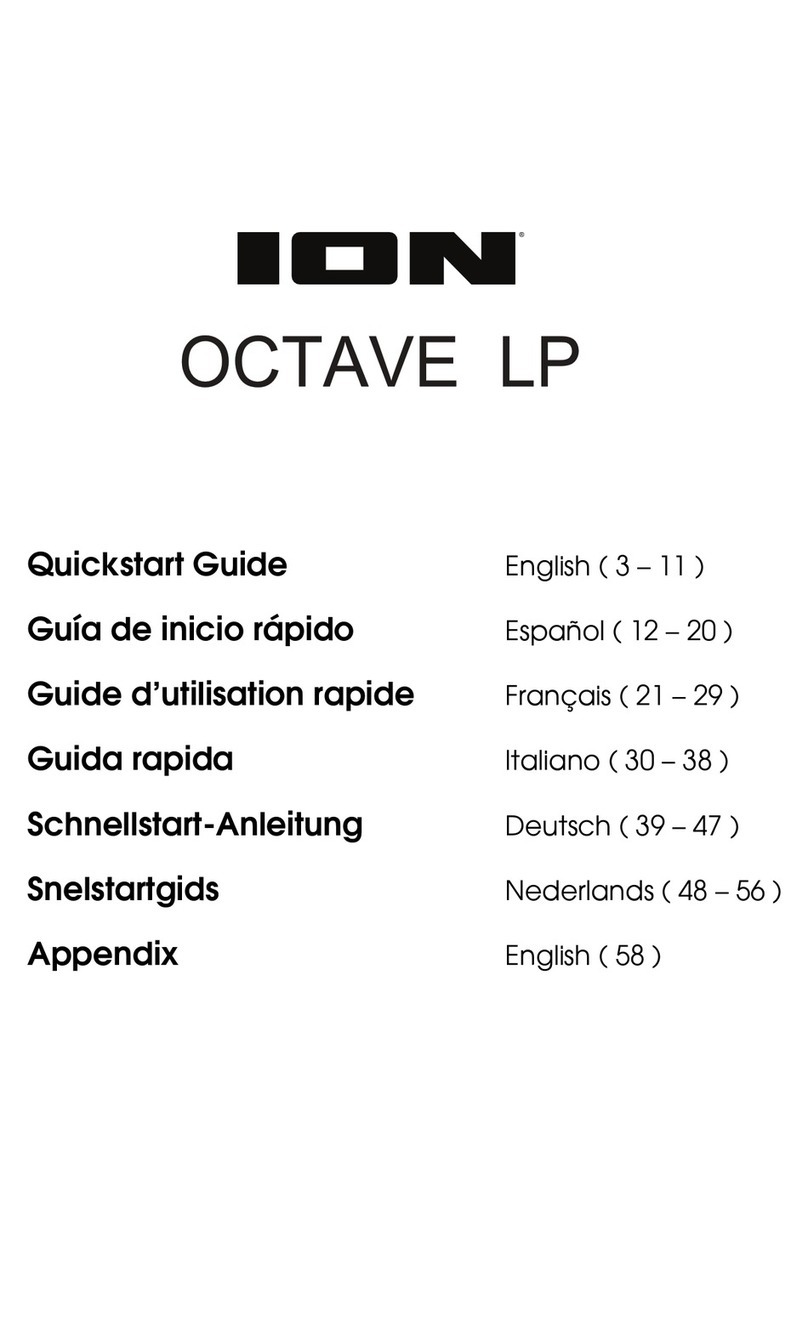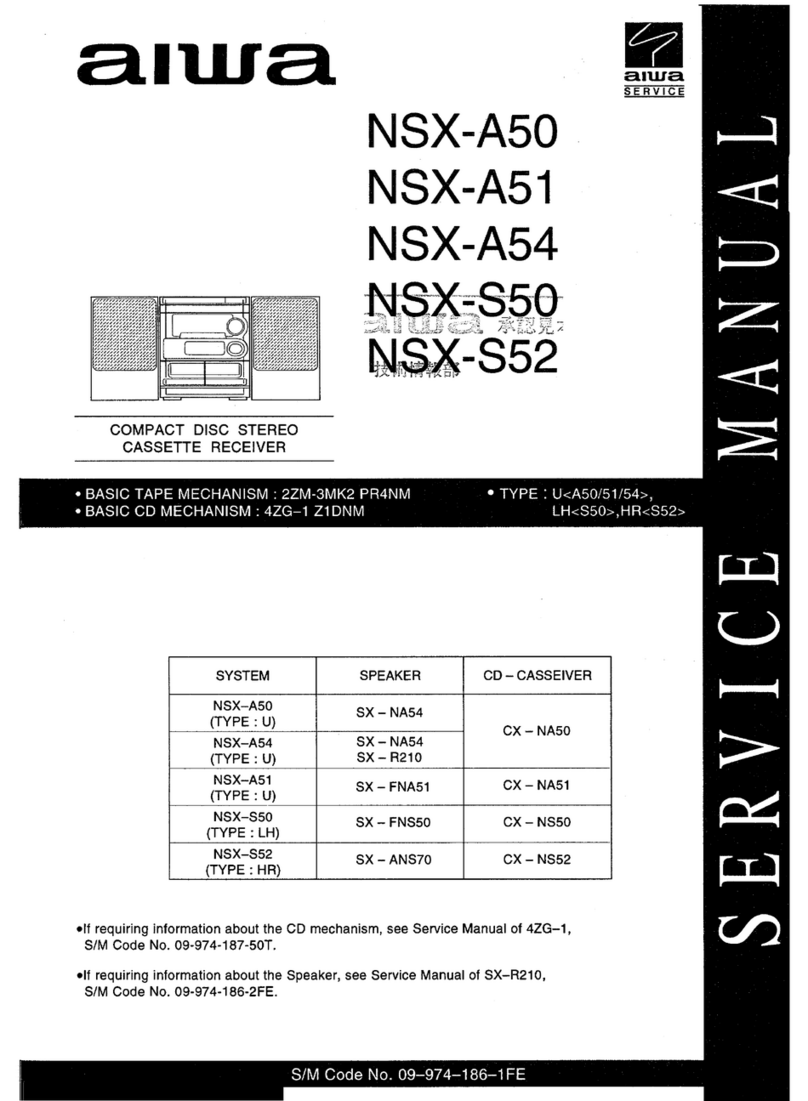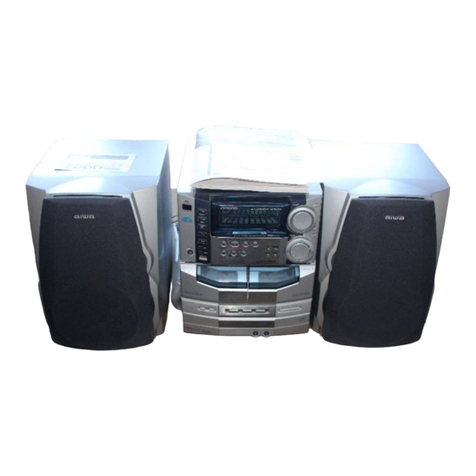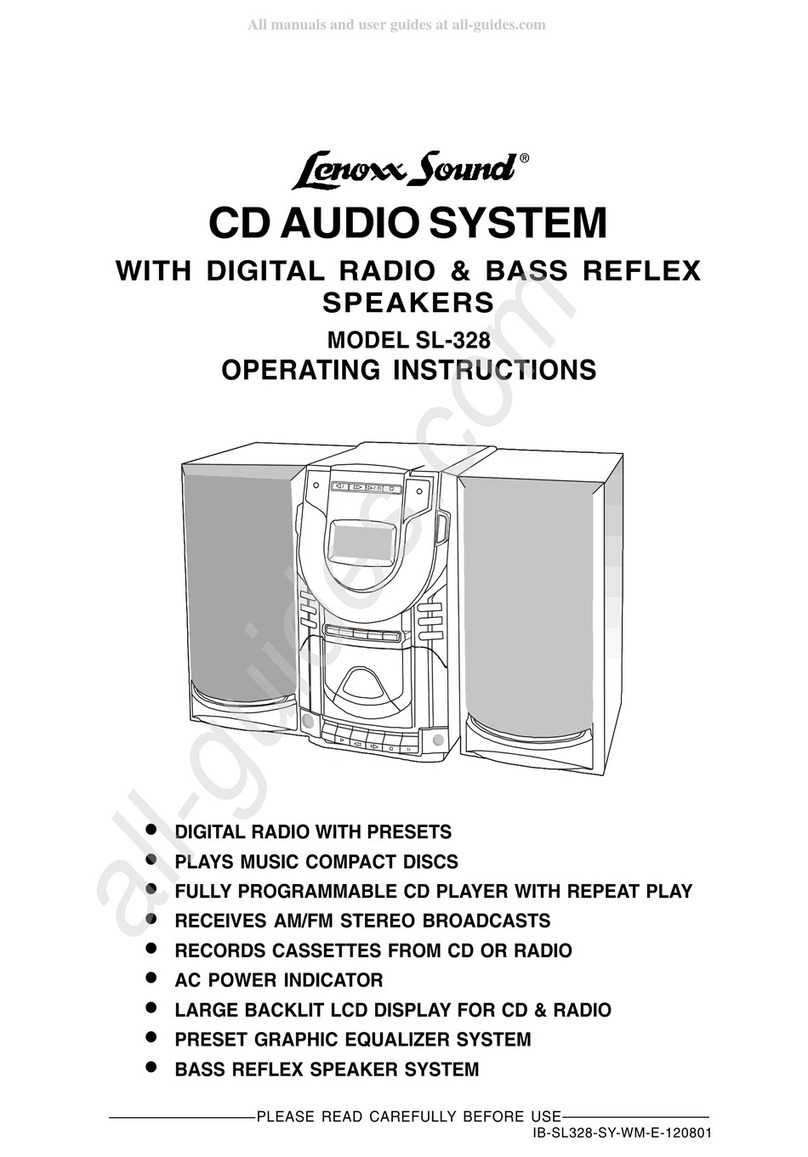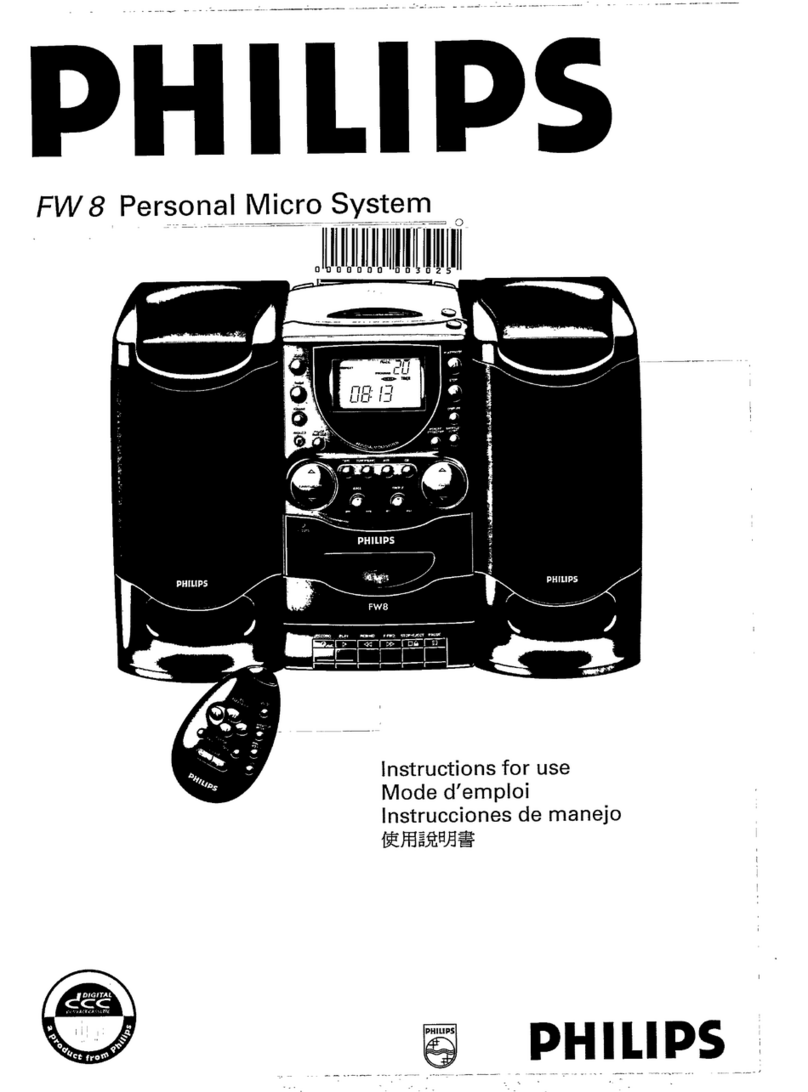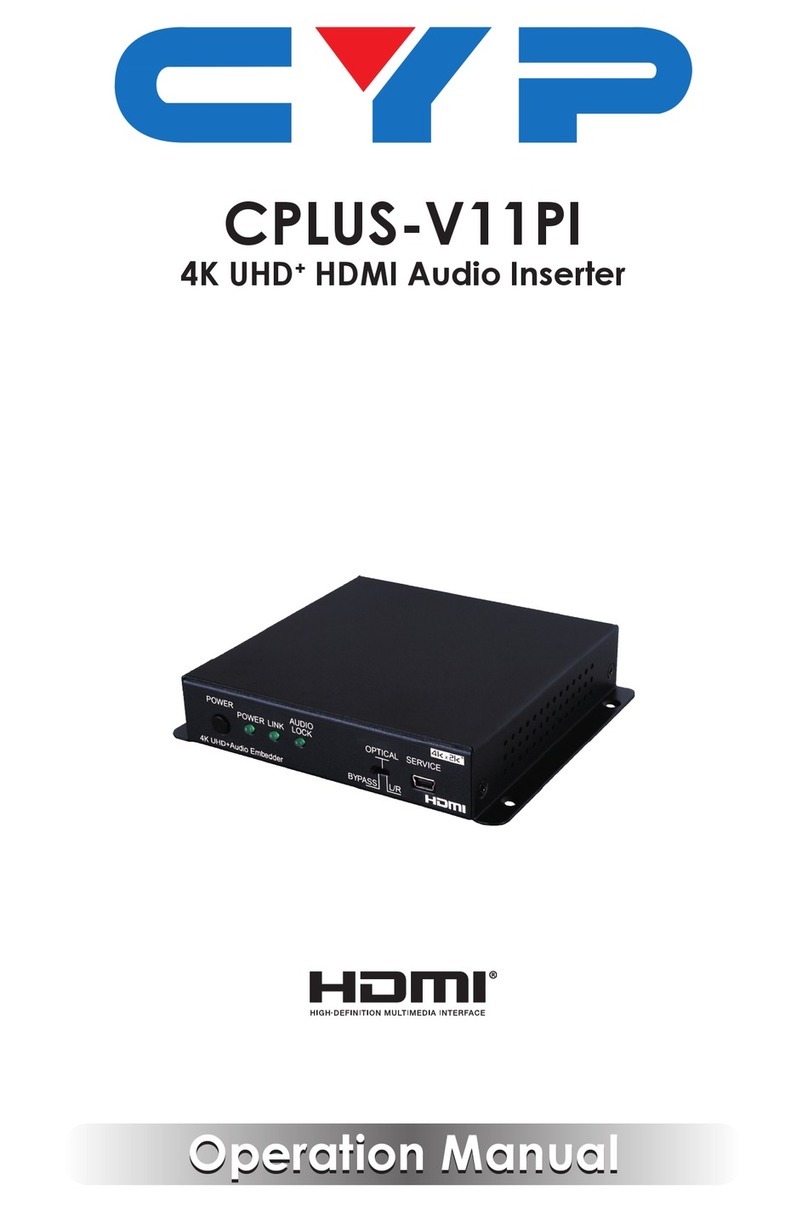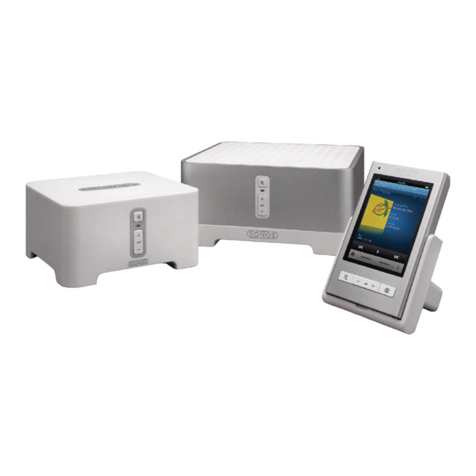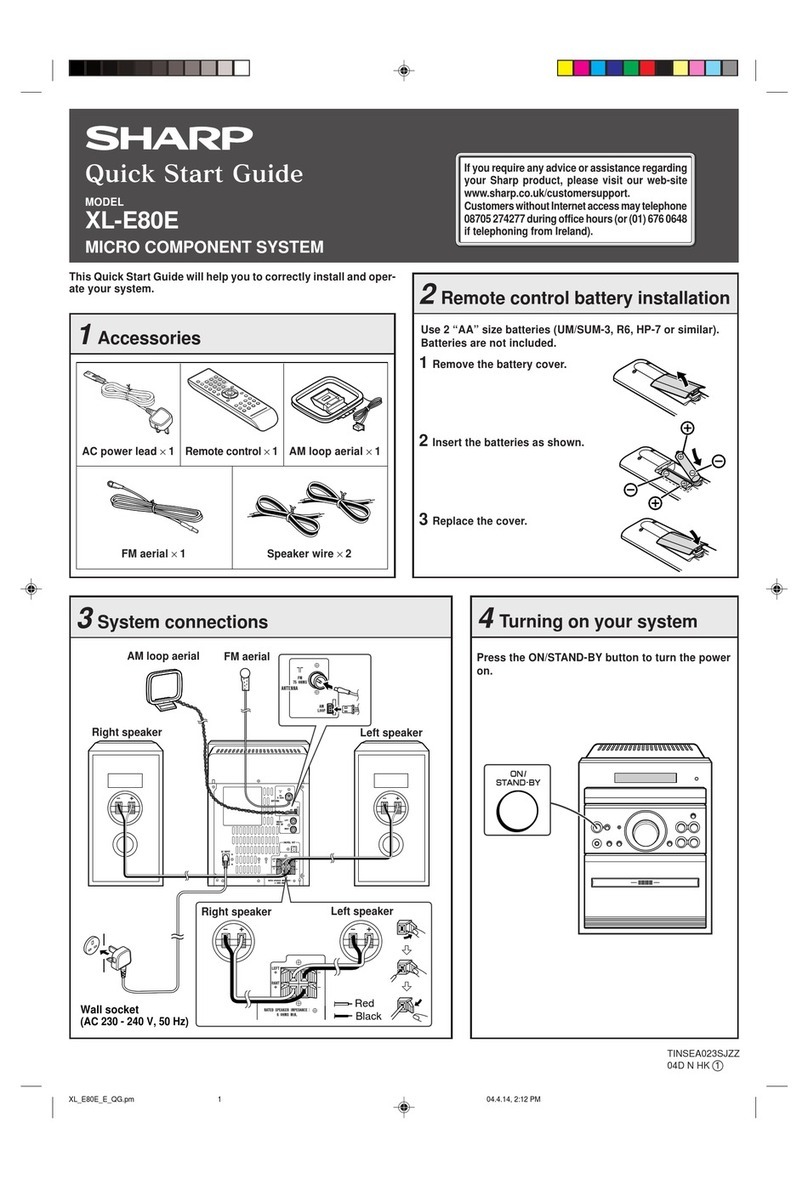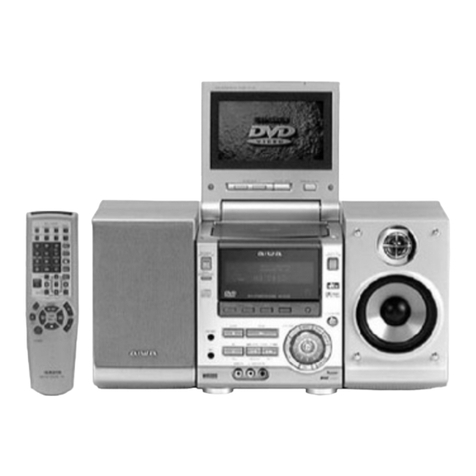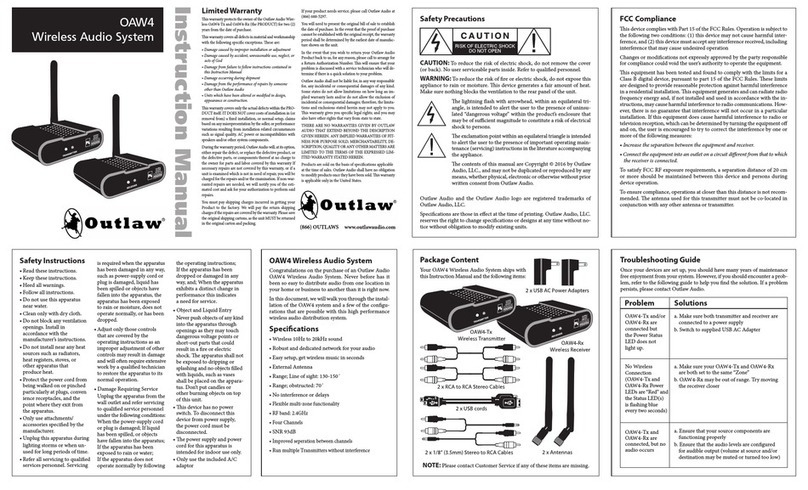HK Audio Cohedra User manual

Manual 3.1
English
co_coco_BDA_de_engl_2.indd 1 18.09.2006 17:08:46

Wichtige Sicherheitshinweise!
Bitte vor Gebrauch lesen und für späteren Gebrauch
aufbewahren!
• Read all of these instructions!
• Save these instructions for later use!
• Follow all warnings and instructions marked on the product!
• Do not use this product near water, i.e. bathtub, sink, swimming
pool, wet basement, etc.
• Do not place this product on an unstable cart, stand or table.
The product may fall, causing serious damage to the product
or to persons!
• Slots and openings in the cabinet and the back or bottom are
provided for ventilation; to ensure reliable operation of the product
and to protect it from overheating, these openings must not be
blocked or covered. This product should not be placed in a built-in
installation unless proper ventilation is provided.
• This product should not be placed near a source of heat such as a
stove, radiator, or another heat producing amplifier.
• Use only the supplied power supply or power cord. If you are not
sure of the type of power available, consult your dealer or local
power company.
• Do not allow anything to rest on the power cord. Do not locate this
product where persons will walk on the cord.
• Never break off the ground pin on the power supply cord.
• Power supply cords should always be handled carefully. Periodically
check cords for cuts or sign of stress, especially at the plug and the
point where the cord exits the unit.
• The power supply cord should be unplugged when the unit is to be
unused for long periods of time.
• If this product is to be mounted in an equipment rack, rear support
should be provided.
• This product should be used only with a cart or stand that is
recommended by HK AUDIO®.
• Never push objects of any kind into this product through cabinet
slots as they may touch dangerous voltage points or short out parts
that could result in risk of fire or electric shock. Never spill liquid of
any kind on the product.
• Do not attempt to service this product yourself, as opening or
removing covers may expose you to dangerous voltage points or
other risks. Refer all servicing to qualified service personnel.
• Unplug this product from the wall outlet and refer servicing to
qualified service personnel under the following conditions:
• When the power cord or plug is damaged or frayed.
• If liquid has been spilled into the product.
• If the product has been exposed to rain or water.
• If the product does not operate normally when the operating
instructions are followed.
• If the product has been dropped or the cabinet has been damaged.
• If the product exhibits a distinct change in performance, indicating a
need of service!
• Adjust only these controls that are covered by the operating
instructions since improper adjustment of other controls may
result in damage and will often require extensive work by a qualified
technician to restore the product to normal operation.
• Exposure to extremely high noise levels may cause a permanent
hearing loss.
• Individuals vary considerably in susceptibility to noise induced
hearig loss, but nearly everyone will lose some hearing if exposed to
sufficiently intense noise for a sufficient time. The U.S. Government´s
Occupational Safety and Health Administration (OSHA) has
specified the following permissible noise level exposures:
Duration Per Day In Hours Sound LeveldBA, Slow Response
8 90
6 92
4 95
3 97
2 100
11/2 102
1 105
1/2 110
1/4 or less 115
• According to OSHA, any exposure in excess of the above permissible
limits could result in some hearing loss.
• Ear plug protectors in the ear canals or over the ears must be worn
when operating this amplification system in order to prevent a
permanent hearing loss if exposure is in excess of the limits as set
forth above. To ensure against potentially dangerous exposure to
high sound pressure levels, it is recommended that all persons
exposed to equipment capable of producing high sound pressure
levels such as this amplification system be protected by hearing
protectors while this unit is in operation.
• Fuses: Replace with IEC 127 (5x 20 mms) type and rated fuse for best
performance only.
TO PREVENT THE RISK OF FIRE AND SHOCK HAZARD, DO NOT
EXPOSE THIS APPLIANCE TO MOISTURE OR RAIN. DO NOT
OPEN CASE;
NO USER SERVICE-ABLE PARTS INSIDE.
REFER SERVICING TO QUALIFIED SERVICE PERSONNEL.
• The unit has been built by HK AUDIO® in accordance with
IEC 60065 and left the factory in safe working order. To maintain this
condition and ensure non-risk operation, the user must follow the
advice and warning comments found in the operating instructions.
The unit conforms to Protection Class 1 (protectively earthed).
• HK AUDIO® ONLY GUARANTEE THE SAFETY, RELIABILITY AND
EFFICIENCY OF THE UNIT IF:
• Assembly, extension, re-adjustment, modifications or repairs are
carried out by HK AUDIO® or by persons authorized to do so.
• The electrical installation of the relevant area complies with the
requirements of IEC (ANSI) specifications.
• The unit is used in accordance with the operating instructions.
• The unit is regularly checked and tested for electrical safety by
a competent technician.
WARNING:
• If covers are opened or sections of casing are removed, except where
this can be done manually, live parts can become exposed.
• If it is necessary to open the unit this must be isolated from all
power sources. Please take this into account before carrying out
adjustments, maintenance, repairs and before replacing parts.
• Adjustment, maintenance and repairs carried out when the unit has
been opened and is still live may only be performed by specialist
personnel who are authorized by the manufacturer (in accordance
with VBG 4) and who are aware of the associated hazards.
• Loudspeaker outputs which have the IEC 417/5036 symbol (Diagram
1, below) can carry voltages which are hazardous if they are made
contact with. Before the unit is switched on, the loudspeaker should
therefore only be connected using the lead recommended by the
manufacturer.
• Where possible, all plugs on connection cables must be screwed
or locked onto the casing.
• Replace with IEC 127 (5x 20 mms) type and rated fuse for best
performance only.
• It is not permitted to use repaired fuses or to short-circuit the fuse
holder.
• Never interrupt the protective conductor connection.
• Surfaces which are equipped with the "HOT" mark (Diagram 2,
below), rear panels or covers with cooling slits, cooling bodies and
their covers, as well as tubes and their covers are purposely designed
to dissipate high temperatures and should therefore
not be touched.
• High loudspeaker levels can cause permanent hearing damage.
You should therefore avoid the direct vicinity of loudspeakers
operating at high levels. Wear hearing protection if continuously
exposed to high levels.
MAINS CONNECTION:
• The unit is designed for continuous operation.
• The set operating voltage must match the local mains supply voltage.
• The unit is connected to the mains via the supplied power unit or
power cable.
• Power unit: Never use a damaged connection lead. Any damage
must be rectified by a competent technician.
• Avoid connection to the mains supply in distributor boxes together
with several other power consumers.
• The plug socket for the power supply must be positioned near the
unit and must be easily accessible.
PLACE OF INSTALLATION:
• The unit should stand only on a clean, horizontal working surface.
• The unit must not be exposed to vibrations during operation.
• Keep away from moisture and dust where possible.
• Do not place the unit near water, baths, wash basins, kitchen sinks,
wet areas, swimming pools or damp rooms. Do not place objects
containing liquid on the unit - vases, glasses, bottles etc.
• Ensure that the unit is well ventilated.
• Any ventilation openings must never be blocked or covered. The unit
must be positioned at least 20 cm away from walls. The unit may
only be fitted in a rack if adequate ventilation is ensured and if the
manufacturer's installation instructions are followed.
• Keep away from direct sunlight and the immediate vicinity of heating
elements and radiant heaters or similar devices.
• If the unit is suddenly moved from a cold to a warm location,
condensation can form inside it. This must be taken into account
particularly in the case of tube units. Before switching on, wait until
the unit has reached room temperature.
• Accessories: Do not place the unit on an unsteady trolley, stand,
tripod, base or table. If the unit falls down, it can cause personal
injury and itself become damaged. Use the unit only with the trolley,
rack stand, tripod or base recommended by the manufacturer or
purchased together with the unit. When setting the unit up, all
the manufacturer's instructions must be followed and the setup
accessories recommended by the manufacturer must be used.
Any combination of unit and stand must be moved carefully. A
sudden stop, excessive use of force and uneven floors can cause the
combination of unit and stand to tip over.
• Additional equipment: Never use additional equipment which
has not been recommended by the manufacturer as this can cause
accidents.
• To protect the unit during bad weather or when left unattended for
prolonged periods, the mains plug should be disconnected. This
prevents the unit being damaged by lightning and power surges in
the AC mains supply.
Diagram 1 Diagram 2
• Das Gerät wurde von HK AUDIO® gemäß IEC 60065 gebaut und hat
das Werk in sicherheitstechnisch einwandfreiem Zustand verlassen. Um
diesen Zustand zu erhalten und einen gefahrlosen Betrieb sicherzustellen,
muss der Anwender die Hinweise und die Warnvermerke beachten, die
in der Bedienungsanleitung enthalten sind. Das Gerät entspricht der
Schutzklasse I (schutzgeerdet).
• DIE SICHERHEIT, ZUVERLÄSSIGKEIT UND LEISTUNG DES GERÄTES
WIRD VON HK AUDIO® NUR DANN GEWÄHRLEISTET, WENN:
• Montage, Erweiterung, Neueinstellung, Änderungen oder Reparaturen von
HK AUDIO® oder von dazu ermächtigten Personen ausgeführt werden.
• die elektrische Installation des betreffenden Raumes den Anforderungen
von IEC (ANSI)-Festlegungen entspricht.
• das Gerät in Übereinstimmung mit der Gebrauchsanweisung verwendet
wird.
WARNUNG:
• Wenn Abdeckungen geöffnet oder Gehäuseteile entfernt werden, außer
wenn dies von Hand möglich ist, können Teile freigelegt werden, die
Spannung führen.
• Wenn ein Öffnen des Gerätes erforderlich ist, muss das Gerät von allen
Spannungsquellen getrennt sein. Berücksichtigen Sie dies vor dem
Abgleich, vor einer Wartung, vor einer Instandsetzung und vor einem
Austausch von Teilen.
• Ein Abgleich, eine Wartung oder eine Reparatur am geöffneten Gerät
unter Spannung darf nur durch eine vom Hersteller autorisierte Fachkraft
(nach VBG 4) geschehen, die mit den verbundenen Gefahren vertraut ist.
• Lautsprecher-Ausgänge, die mit dem IEC 417/5036-Zeichen (Abb.1,
s.unten) versehen sind, können berührungsgefährliche Spannungen
führen. Deshalb vor dem Einschalten des Gerätes Verbindung nur mit
dem vom Hersteller empfohlenen Anschlusskabel zum Lautsprecher
herstellen.
• Alle Stecker an Verbindungskabeln müssen mit dem Gehäuse verschraubt
oder verriegelt sein, sofern möglich.
• Es dürfen nur Sicherungen vom angegebenen Typ und der angegebenen
Nennstromstärke als Ersatz verwendet werden.
• Eine Verwendung von geflickten Sicherungen oder Kurzschließen des
Halters ist unzulässig.
• Niemals die Schutzleiterverbindung unterbrechen.
• Oberflächen, die mit dem "HOT"-Zeichen (Abb.2, s.unten) versehen sind,
Rückwände oder Abdeckungen mit Kühlschlitzen, Kühlkörper und deren
Abdeckungen, sowie Röhren und deren Abdeckungen können im Betrieb
erhöhte Temperaturen annehmen und sollten deshalb nicht berührt
werden.
• Hohe Lautstärkepegel können dauernde Gehörschäden verursachen.
Vermeiden Sie deshalb die direkte Nähe von Lautsprechern, die mit
hohen Pegeln betrieben werden. Verwenden Sie einen Gehörschutz bei
dauernder Einwirkung hoher Pegel.
NETZANSCHLUSS:
• Das Gerät ist für Dauerbetrieb ausgelegt.
• Die eingestellte Betriebsspannung muss mit der örtlichen Netzspannung
übereinstimmen.
• Der Anschluss an das Stromnetz erfolgt mit dem mitgelieferten Netzteil
oder Netzkabel.
• Netzteil: Eine beschädigte Anschlussleitung kann nicht ersetzt werden.
Das Netzteil darf nicht mehr betrieben werden.
• Vermeiden Sie einen Anschluss an das Stromnetz in Verteilerdosen
zusammen mit vielen anderen Stromverbrauchern.
• Die Steckdose für die Stromversorgung muss nahe am Gerät angebracht
und leicht zugänglich sein.
AUFSTELLUNGSORT:
• Das Gerät sollte nur auf einer sauberen, waagerechten Arbeitsfläche stehen.
• Das Gerät darf während des Betriebs keinen Erschütterungen ausgesetzt
sein.
• Feuchtigkeit und Staub sind nach Möglichkeit fernzuhalten.
• Das Gerät darf nicht in der Nähe von Wasser, Badewanne, Waschbecken,
Küchenspüle, Nassraum, Swimmingpool oder feuchten Räumen betrieben
werden. Keine mit Flüssigkeit gefüllten Gegenstände -Vase, Gläser,
Flaschen etc. auf das Gerät stellen.
• Sorgen Sie für ausreichende Belüftung der Geräte.
• Eventuelle Ventilationsöffnungen dürfen niemals blockiert oder
abgedeckt werden. Das Gerät muss mindestens 20 cm von Wänden
entfernt aufgestellt werden. Das Gerät darf nur dann in ein Rack
eingebaut werden, wenn für ausreichende Ventilation gesorgt ist und die
Einbauanweisungen des Herstellers eingehalten werden.
• Vermeiden Sie direkte Sonneneinstrahlung sowie die unmittelbare Nähe
von Heizkörpern und Heizstrahlern oder ähnlicher Geräte.
• Wenn das Gerät plötzlich von einem kalten an einen warmen Ort gebracht
wird, kann sich im Geräteinnern Kondensfeuchtigkeit bilden. Dies ist
insbesondere bei Röhrengeräten zu beachten. Vor dem Einschalten
solange warten bis das Gerät Raumtemperatur angenommen hat.
• Zubehör: Das Gerät nicht auf einen instabilen Wagen, Ständer, Dreifuß,
Untersatz oder Tisch stellen. Wenn das Gerät herunterfällt, kann es
Personenschäden verursachen und selbst beschädigt werden.
Verwenden Sie das Gerät nur mit einem vom Hersteller empfohlenen oder
zusammen mit dem Gerät verkauften Wagen, Rack, Ständer, Dreifuß oder
Untersatz. Bei der Aufstellung des Gerätes müssen die Anweisungen des
Herstellers befolgt und muss das vom Hersteller empfohlene Aufstell-
zubehör verwendet werden. Eine Kombination aus Gerät und Gestell
muss vorsichtigt bewegt werden. Plötzliches Anhalten, übermäßige
Kraftanwendung und ungleichmäßige Böden können das Umkippen
der Kombination aus Gerät und Gestell bewirken.
• Zusatzvorrichtungen: Verwenden Sie niemals Zusatzvorrichtungen, die
nicht vom Hersteller empfohlen wurden, weil dadurch Unfälle verursacht
werden können
• Zum Schutz des Gerätes bei Gewitter oder wenn es längere Zeit nicht
beaufsichtigt oder benutzt wird, sollte der Netzstecker gezogen werden.
Dies verhindert Schäden am Gerät aufgrund von Blitzschlag und
Spannungsstößen im Wechselstromnetz.
Abb.1 Abb.2
Important Safety Instructions
Before connecting, read instructions
Important Advice on Safety!
Please read before use and keep for later use!
co_coco_BDA_de_engl_2.indd 2 18.09.2006 17:08:46

• L'appareil a été conçu par HK AUDIO® selon la norme IEC 60065 et
a quitté l'entreprise dans un état irréprochable. Afin de conserver cet
état et d'assurer un fonctionnement sans danger de l'appareil nous
conseillons à l'utilisateur la lecture des indications de sécurité contenues
dans le mode d'emploi. L'appareil est conforme à la classification I
(mise à terre de protection).
• SURETE, FIABILITE ET EFFICACITE DE L'APPAREIL NE SONT
GARANTIS PAR HK AUDIO® QUE SI:
• Montage, extension, nouveau réglage, modification ou réparation
sont effectués par HK AUDIO® ou par toute personne autorisée
par HK AUDIO®.
• L'installation électrique de la pièce concernée correspond aux normes
IEC (ANSI).
• L'utilisation de l'appareil suit le mode d'emploi.
AVERTISSEMENT:
• A moins que cela ne soit manuellement possible, tout enlèvement
ou ouverture du boîtier peut entrainer la mise au jour de pieces
sous tension.
• Si l'ouverture de l'appareil est nécessaire, celui-ci doit être coupé de
chaque source de courant. Ceci est à prendre en considération avant
tout ajustement, entretien, réparation ou changement de pieces.
• Ajustement, entretien ou réparation sur l'appareil ouvert et sous
tension ne peuvent être éffectués que par un spécialiste autorisé par le
fabricant (selon VBG4). Le spécialiste étant conscient des dangers liés
à ce genre de réparation.
• Les sorties de baffles qui portent le signe IEC 417/5036 (fig. 1, voir
en bas) peuvent être sous tension dangereuse. Avant de brancher
l'appareil utiliser uniquement le câble de raccordement conseillé par
le fabricant pour raccorder les baffles.
• Toutes les prises des câbles de raccordement doivent être, si possible,
vissées ou verrouillées sur le boîtier.
• Utilisez subsidiairement uniquement des fusibles de type et de
puissance de courant nominale donnés.
• L'utilisation de fusibles rafistolés ou court-circuites est inadmissible.
• Ne jamais interrompre la connexion du circuit protecteur.
• Il est conseillé de ne pas toucher aux surfaces pourvues du signe
"HOT" (fig. 2, voir en bas), aux parois arrières ou caches munis de
fentes d'aération, éléments d'aération et leurs caches ansi qu'aux
tubes et leurs caches. Ces éléments pouvant atteindre des
températures élévées pendant l'utilisation de l'appareil.
• Les Niveaux de puissance élévés peuvent entrainer des lésions auditives
durables. Evitez donc la proximité de haut-parleurs utilisés à haute
puissance. Lors de haute puissance continue utilisez une protection
auditive.
BRANCHEMENT SUR LE SECTEUR:
• L'appareil est conçu pour une utilisation continue.
• La tension de fonctionnement doit concorder avec la tension secteur
locale.
• Le raccordement au réseau éléctrique s'effectue avec l'adaptateur ou le
cordon d´alimentation livré avec l'appareil.
• Adaptateur: Un câble de raccordement abimé ne peut être remplacé.
L'adaptateur est inutilisable.
• Evitez un raccordement au réseau par des boîtes de distribution
surchargées.
• La prise de courant doit être placée à proximité de l'appareil et facile
à atteindre.
LIEU D'INSTALLATION:
• L'appareil doit être placé sur une surface de travail propre et horizontale.
• L'appareil en marche ne doit en aucun cas subir des vibrations.
• Evitez dans la mesure du possible poussière et humidité.
• L'appareil ne doit pas être placé à proximité d'eau, de baignoire,
lavabo, évier, pièce d'eau, piscine ou dans une pièce humide.
Ne placez aucun vase, verre, bouteille ou tout objet rempli de liquide
sur l'appareil.
• L'appareil doit être suffisamment aéré.
• Ne jamais recouvrir les ouvertures d'aération. L'appareil doit être
placé à 20 cm du mur au minimum. L'appareil peut être monté dans
un Rack si une ventilation suffisante est possible et si les conseils de
montage du fabricant sont suivis.
• Evitez les rayons de soleil et la proximité de radiateurs, chauffages etc.
• Une condensation d'eau peut se former dans l'appareil si celui-ci est
transporté brusquement d'un endroit froid à un endroit chaud.
Ceci est particulièrement important pour des appareils à tubes.
Avant de brancher l'appareil attendre qu'il ait la température ambiante.
• Accessoires: L'appareil ne doit être placé sur un chariot, support,
trépied, bâti ou table instable. Une chute de l'appareil peut entrainer
aussi bien des dommages corporels que techniques. Utilisez l'appareil
uniquement avec un chariot, Rack, support, trépied ou bâti conseillé
par le fabricant ou vendu en combinaison avec l'appareil.
Les indications du fabricant pour l'installation de l'appareil sont à
suivre, et les accessoires d'installation conseillés par le fabricant sont
à utiliser. Un ensemble support et appareil doit être déplacé avec
précaution. Des mouvements brusques et des revêtements de sol
irreguliers peuvent entrainer la chute de l´ensemble.
• Equipements supplémentaires: Ne jamais utiliser un équipement
supplémentaire n'ayant pas été conseillé par le fabricant, ceci pouvant
entrainer des accidents.
• Afin de protéger l'appareil pendant un orage ou s'il ne doit pas être
utilisé pendant un certain temps, il est conseillé d'enlever la prise
au secteur. Ceci évite des dommages dûs à la foudre ou à des coups de
tension dans le réseau à courant alternatif.
Fig. 1 Fig. 2
• L'apparecchio è stato costruito dalla HK AUDIO® secondo la normativa
europea IEC 60065 ed ha lasciato il nostro stabilimento in stato
ineccepibile. Per garantire il mantenimento di tale stato e un utilizzo
assolutamente privo di rischi l'utente è tenuto ad osservare le indicazioni
e gli avvertimenti di sicurezza contenuti nelle istruzioni per l'uso.
L'apparecchio rispecchia il livello di sicurezza I (collegato a terra).
• Sicurezza, affidabilità e prestazioni dell'apparecchio vengono garantiti
dalla HK AUDIO® solo ed esclusivamente se:
• Montaggio, ampliamento, rimessa a punto, modifiche e riparazioni
vengono eseguite dalla HK AUDIO® stessa o da personale da essa
autorizzato.
• Gli impianti elettrici nei locali prescelti per l'uso dell'apparecchio
rispondono alle normative stabilite dall'ANSI.
• L'apparecchio viene utilizzato come indicato nel libretto delle istruzioni
per l'uso.
Avvertimenti:
• In caso di apertura di parti di rivestimento o rimozione di parti
dell'involucro, a meno che non si tratti di pezzi rimovibili semplicemente
a mano, possono venire alla luce parti dell'apparecchio conduttrici di
tensione.
• Se l'apertura dell'apparecchio dovesse risultare necessaria è indispensabile
staccare precedentemente quest'ultimo da tutte le fonti di tensione.
Rispettare tale misura di prevenzione anche prima di un allineamento, di
operazioni di manutenzione, della messa in esercizio o della sostituzione
di componenti all'interno dell'apparecchio.
• Allineamento, operazioni di manutenzione o eventuali riparazioni
dell'apparecchio in presenza di tensione vanno eseguite esclusivamente
da personale specializzato ed autorizzato, in grado di eseguire tali
operazioni evitandone i rischi connessi.
• Le uscite degli altoparlanti contrassegnate dai caratteri IEC 417/5036
(vedi illustrazione 1 a fondo pag.) possono essere conduttrici di
tensione pericolosa con cui evitare il contatto. Per questo motivo, prima
di accendere l'apparecchio, collegare quest'ultimo agli altoparlanti
servendosi esclusivamente del cavetto d'allacciamento indicato
dal produttore.
• Tutte le spine e i cavi di collegamento devono essere avvitati o fissati
all'involucro dell'apparecchio per quanto possibile.
• Tutti i fusibili di sicurezza vanno sostituiti esclusivamente con fusibili del
tipo prescritto e valore della corrente nominale indicato.
• L'utilizzo di fusibili di sicurezza non integri e la messa in corto circuito
del sostegno di metallo sono proibite.
• Non interrompere mai il collegamento con il circuito di protezione.
• Superfici contrassegnate dalla parola "HOT" (vedi illustrazione 2 a fondo
pag.), cosi come griglie di aerazione, dispositivi di raffreddamento e i
loro rivestimenti di protezione, oppure valvole e i relativi rivestimenti
protettivi possono surriscaldarsi notevolmente durante l'uso e per questo
motivo non vanno toccate.
• L'ascolto di suoni ad alto volume può provocare danni permanenti
all'udito. Evitate perciò la diretta vicinanza con altoparlanti ad alta
emissione di suono e utilizzate cuffie protettive in caso ciò non sia
possibile.
Alimentazione:
• L'apparecchio è concepito per il funzionamento continuo.
• La tensione di esercizio deve corrispondere alla tensione di rete a cui ci
si allaccia.
• L'allacciamento alla rete elettrica avviene tramite alimentatore o cavetto
d'alimentazione consegnato insieme all'apparecchio.
• Alimentatore: un cavo di connessione danneggiato non può essere
sostituito. L'alimentatore non può più essere utilizzato.
• Evitate un allacciamento alla rete di corrente utilizzando cassette di
distribuzione sovraccariche.
• La spina di corrente deve essere situata nelle vicinanze dell'apparecchio
e facilmente raggiungibile in qualsiasi momento.
Locali di collocamento:
• Opportuno collocare l'apparecchio su una superficie pulita e orizzontale.
• Non sottoporre l'apparecchio in funzione a scosse e vibrazioni.
• Proteggere l'apparecchio per quanto possibile da umidità e polvere.
• Non collocare l'apparecchio vicino ad acqua, vasche da bagno, lavandini,
lavelli da cucina, locali umidi o piscine. Non appoggiare recipienti
contenenti liquidi - vasi, bicchieri, bottiglie, ecc. - sull'apparecchio.
• Provvedere ad una buone aerazione dell'apparecchio.
• Eventuali aperture previste per la ventilazione dell'apparecchio non
vanno ne bloccate, ne mai coperte. L'apparecchio va collocato ad almeno
20 cm di distanza dalle pareti circostanti e può essere inserito tra altre
componenti di un impianto solo in caso di sufficiente ventilazione e
qualora le direttive di montaggio del produttore vengano rispettate.
• Evitare di esporre l'apparecchio ai raggi del sole e di collocarlo
direttamente nelle vicinanze di fonti di calore come caloriferi, stufette,
ecc.
• Se l'apparecchio viene trasportato rapidamente da un locale freddo ad
uno riscaldato può succedere che al suo interno si crei della condensa.
Ciò va tenuto in considerazione soprattutto in caso di apparecchi a valvole.
Attendere che l'apparecchio abbia assunto la temperatura ambiente prima
di accenderlo.
• Accessori: non collocare l'apparecchio su carrelli, supporti, treppiedi,
superfici o tavoli instabili. Se l'apparecchio dovesse cadere a terra
potrebbe causare danni a terzi o danneggiarsi irreparabilmente. Utilizzate
per il collocamento dell'apparecchio supporti, treppiedi e superfici che
siano consigliate dal produttore o direttamente comprese nell'offerta di
vendita. Per il collocamento dell'apparecchio attenetevi strettamente alle
istruzioni del produttore, utilizzando esclusivamente accessori da esso
consigliati. L'apparecchio in combinazione ad un supporto va spostato
con molta attenzione. Movimenti bruschi o il collocamento su pavimenti
non piani possono provocare la caduta dell'apparecchio e del suo
supporto.
• Accessori supplementari: non utilizzate mai accessori supplementari che
non siano consigliati dal produttore, potendo essere ciò causa di incidenti.
• Per proteggere l'apparecchio in caso di temporali o nel caso questo non
venisse utilizzato per diverso tempo si consiglia di staccarne la spina di
corrente. In questo modo si evitano danni all'apparecchio dovuti a colpi
di fulmine o ad improvvisi aumenti di tensione nel circuito di corrente
alternata.
Illustrazione 1 Illustrazione 2
• El aparato ha sido producido por HK AUDIO® según el IEC 60065 y salió
de la fábrica en un estado técnicamente perfecto. Para conservar este
estado y asegurar un funcionamiento sin peligros el usuario debe tener
en cuenta las indicaciones y advertencias contenidas en las instrucciones
de manejo. l aparato corresponde a la clase de protección l (toma de
tierra protegida).
• LA SEGURIDAD, LA FIABILIDAD Y EL RENDIMIENTO DEL APARATO
SOLO ESTAN GARANTIZADOS POR HK AUDIO® CUANDO:
• el montaje, la ampliación, el reajuste, los cambios o las reparaciones
se realicen por HK AUDIO® o por personas autorizadas para ello;
• la instalación eléctrica del recinto en cuestión corresponda a los
requisitos de la determinación del IEC (ANSI);
• el aparato se use de acuerdo con las indicaciones de uso.
ADVERTENCIA:
• Si se destapan protecciones o se retiran piezas de la carcasa, exceptuando
si se puede hacer manualmente, se pueden dejar piezas al descubierto
que sean conductoras de tensión.
• Si es necesario abrir el aparato, éste tiene que estar aislado de todas las
fuentes de alimentación. Esto se debe tener en cuenta antes del ajuste, de
un entretenimiento, de una reparación y de una sustitución de
las piezas.
• Un ajuste, un entretenimiento o una reparación en el aparato abierto y
bajo tensión sólo puede ser llevado a cabo por un especialista autorizado
por el productor (según VBG 4) que conozca a fondo los peligros que ello
conlleva.
• Las salidas de altavoces que estén provistas de la característica
IEC 417/5036 (figura 1, véase abajo) pueden conducir tensiones
peligrosas al contacto. Por ello es indispensable que antes de poner en
marcha el aparato; la conexión se haya realizado únicamente con el cable
de empalmes recomendado por el productor.
• Las clavijas de contacto al final de los cables conectores tienen que estar
atornilladas o enclavadas a la carcasa, en tanto que sea posible.
• Los fusibles de repuesto que se utilicen sólo pueden ser del tipo indicado
y tener la intensidad nominal indicada.
• El uso de fusibles reparados o la puesta en cortocircuito del soporte es
inadmisible.
• El empalme del conductor de protección no se puede interrumpir en
ningún caso.
• Las superficies provistas de la característica "HOT" (figura 2, véase
abajo), los paneles de fondo trasero o las protecciones con ranuras de
ventilación, los cuerpos de ventilación y sus protecciones, así como las
válvulas electrónicas y sus protecciones pueden alcanzar temperaturas
muy altas durante el funcionamiento y por ello no se deberían tocar.
• Niveles elevados de la intensidad de sonido pueden causar continuos
daños auditivos; por ello debe evitar acercarse demasiado a altavoces que
funcionen a altos niveles. En tales casos utilice protecciones auditivas.
ACOMETIDA A LA RED:
• El aparato está proyectado para un funcionamiento continuo.
• La tensión de funcionamiento ajustada tiene que coincidir con la tensión
de la red del lugar.
• La conexión a la red eléctrica se efectuará con la fuente de alimentación
o con el cable de red que se entreguen con el aparato.
• Fuente de alimentación: una linea de conexión dañada no se puede
sustituir. La fuente de alimentación no puede volver a ponerse en
funcionamiento.
• Evite una conexión de la red eléctrica a distribuidores con muchas tomas
de corriente.
• El enchufe para el suministro de corriente tiene que estar cerca del
aparato y ser de fácil acceso.
SITUACION:
• El aparato debería estar situado en una superficie limpia y totalmente
horizontal.
• El aparato no puede estar expuesto a ningún tipo de sacudidas durante
su funcionamiento.
• Se deben evitar la humedad y el polvo.
• El aparato no puede ponerse en funcionamiento cerca del agua, la bañera,
el lavamanos, la pila de la cocina, un recinto con tuberías de agua,
la piscina o en habitaciones húmedas. Tampoco se pueden poner objetos
llenos de líquido - jarrones, vasos, botellas, etc. - encima de él.
• Procure que el aparato tenga suficiente ventilación.
• Las aberturas de ventilación existentes no se deben bloquear ni
tapar nunca. El aparato debe estar situado como mínimo a 20 cm de la
pared. El aparato sólo se puede montar en un rack, si se ha procurado la
suficiente ventilación y se han cumplido las indicaciones de montaje
del productor.
• Evite los rayos del sol directos así como la proximidad a radiadores,
electro-radiadores o aparatos similares.
• Si el aparato pasa repentinamente de un lugar frío a otro caliente, se
puede condensar humedad en su interior. Esto se debe tener en cuenta
sobretodo en los aparatos con válvulas electrónicas. Antes de poner
en marcha el aparato se debe esperar hasta que éste haya adquirido la
temperatura ambiental.
• Accesorios: el aparato no se puede colocar encima de carros, estantes,
trípodes, soportes o mesas inestables. Si el aparato se cae puede causar
daños personales y se puede estropear. Coloque el aparato sólo en un
carro, rack, estante, trípode o soporte recomendado por el productor o
que se le haya vendido junto con el aparato. En la instalación se deben
seguir las indicaciones del productor así como utilizar los accesorios
recomendados por el mismo para colocarlo encima. El conjunto del
aparato con el pedestal se debe mover con mucho cuidado. Un paro
brusco, la aplicación de una fuerza desmesurada o un suelo irregular
puede ocasionar la caida de todo el conjunto.
• Piezas adicionales: no utilice nunca piezas adicionales que no estén
recomendadas por el productor, ya que se podrían provocar accidentes.
• Para protejer el aparato de una tormenta o si no se supervisa ni utiliza
durante algún tiempo, se debería desconectar la clavija de la red. Así se
evitan daños en el aparato a causa de un rayo y golpes de tensión en la
red de corriente alterna.
Figura 1 Figura 2
Conseils de Securite Importants!
Priere de lire avant l'emploi et a conserver pour
utilisation ulterieure!
Importanti avvertimenti di sicurezza!
Leggere attentamente prima dell'uso e conservare
per un utilizzo successivo:
¡Indicaciones de seguridad importantes!
¡Léanse antes de utilizar el aparato y guardense para
so uso posterior!
co_coco_BDA_de_engl_2.indd 3 18.09.2006 17:08:47

Manual
COHEDRA® & COHEDRA® Compact
Preface
This manual is addressed to all technicians who are responsible for setting up, operating and maintaining
the HK Audio® Cohedra™ Compact system. In addition, we would like to explain in detail the principles and
functions of HK Audio® Cohedra™ technology to all interested planning and installation engineers.
Content
A Die COHEDRA® Technology .....................................5
B COHEDRA® Enclosures ...........................................10
B 1 COHEDRA® Compact Enclosures .........................14
C COHEDRA® Transport Solution ...........................17
C 1 COHEDRA® Compact Transport Solution ..........20
D Rigging and Curving COHEDRA® Systems .........22
D 1 Rigging and Curving COHEDRA® Compact ........36
E COHEDRA® Setups with CAPS .................................48
F COHEDRA® Controlling Concept ........................61
G Controller and Controller Software ...............63
H COHEDRA® Power-Racks ..........................................81
I Power Amp VX 2400 ...................................................85
J Patchbay PB5 ..............................................................90
K Service COHEDRA® ....................................................95
K 1 Service COHEDRA® Compact ...................................98
L Appendix/Reference library .................................100
co_coco_BDA_de_engl_2.indd 4 18.09.2006 17:08:48

5
A
1 Line Array Approaches in Recent Years ............6
2 Development Objectives ................................ 7
2.1 High Frequency Range .................................... 7
2.2 Middle Frequency Range ..................................7
2.3 Low Frequency Range .......................................7
3 Emphasized Radiation Technology™ ............... 7
3.1 The High Frequency Wave Front .......................8
3.2 Midrange ..........................................................8
3.3 The Subwoofer-Truest Dynamic Response ..........9
Index of Figures:
Fig. 1: Comparison of a 4 m array's near-to-far
field transition in theory and practice ........6
Fig. 2: Gap due to curving ....................................6
Fig. 3: Emphasized radiation in a line array ..........7
Fig. 3.1: Extended line Array near-field ....................7
Fig. 4: Effect without gap (red), with evenly
distributed gap (blue), and with
unevenly distributed gap (pink) .................7
Fig. 5: Typical J shape ...........................................7
Fig. 6: The COHEDRA® acoustic lens'
mode of operation .....................................8
Fig. 7: The COHEDRA® acoustic lens ...................8
Fig. 8: Effect of the synthetic fiber fleece ..............9
Fig. 9: Front view of the COHEDRA®
CDR 208 mid/high enclosure ....................9
Fig. 10: 8" speaker cover serving as a
CD horn and part of the
compression chamber ...............................9
Fig. 11: Comparison of moving masses ..................9
Fig. 12: Impulse response: ideal (blue),
10" (red), 18" (purple) ...............................9
Chapter A
The COHEDRA
®
Technology
co_coco_BDA_de_engl_2.indd 5 18.09.2006 17:08:48

Manual
COHEDRA® & COHEDRA® Compact
1 Line Array Approaches
in Recent Years
Line arrays are a fixture on the contemporary sound
reinforcement scene. The design principle has its
origins in the stacks of cone loudspeakers that were
popular in the '70s.
Some 20 years later, the coherent wave front's ingress
into the high frequency range through waveguides
and acoustical mirrors ushered in a second genera-
tion of line arrays.
Here a line source makes use of the near field's dif-
fusion. At a certain distance, the radiated cylindrical
wave front's near field transitions into a spherical
wave front. This transition from a cylindrical to a
spherical wave is contingent upon the length of the
radiator and the radiated frequency. The following
formula by Christian Heil serves to calculate the
distance at which this transition occurs:
H in meters, f in kHz
Mark Ureda, in turn, proposed a somewhat diffe-
rent formula for calculating the ratio between the
near and far fields:
l in meters, f in Hz
However, when these formulae are charted in a
graphical comparison, it is evident that their results
are quite similar.
Though in general it would appear that all aspects
of modern line arrays have been described ex-haus-
tively, practical applications reveal some deficiencies.
According to the aforementioned formulae, at a fre-
quency of 16 kHz the near field of a line array with
the length of 4 m extends out to 380 m!
Anyone who has heard a line array of comparable
size perform is sure to confirm that this great a
range cannot be attained in a real-world scenario.
The fact is that these values must be scaled down
substantially (see Fig. 1). Consequently, the afore-
mentioned formulae for a continuous line source
are more theoretical in nature.
Why these differences between theory and practice,
and why does a cylindrical wave transition into a
spherical wave front rather than diffuse infinitely?
The answer is quite simple in view of the molecular
structure of air. Air molecules offer frictional resis-
tance, impeding the sound wave's diffusion.
Some sound molecules drift outwards when the
wave's impact excites inert molecules at its fringes.
The cylindrical wave front's keen edges are smoothed
by degrees, gradually transforming the cylindrical
wave into a spherical wave front.
In mathematical terms, this can be described as
a sound vector pointing slightly outward at its
fringes. Because the velocity of propagation remains
constant, the cylindrical wave slowly tran-sition into
a spherical wave.
Technical literature describes the molecular frictional
resistance of air as atmospheric absorption of sound,
which increases exponentially as the frequency rises.
Accordingly, frictional resistance is greater at higher
frequencies, meaning that at higher frequencies,
the transition described occurs at a closer distance
(or smaller ratio).
Similar effects have been observed in analog tech-
nology where a square signal is smoothed by a
low-pass filter. It can be said that at some point
the signal regains a sine-like form.
Values that are possible in theory are again reduced
in practice because the line source is not in fact
continuous in the high frequency range; instead,
it is composed of individual segments. Even with
the most painstaking effort, it is impossible to prevent
interference with or drop-outs of the continuous line
source in practical applications because housings
and edge diffraction inevitably cause some interfe-
rence.
Furthermore, in theory this continuous line source
would always be linear! However, gaps are created
in the air when an array is curved, tearing the line
source apart and further reducing the range.
In order to preclude the phenomenon of gaps created
by curving, a line array would have to consist of very
many individual elements (N=>00), which unfortu-
nately is practically infeasible (see Fig. 2 a, 2 b).
An effort to take these deficiencies into account led
to a next generation line array, with the following
section examines.
Consequently, all the aforementioned formulae
concerning a continuous line source are purely
theoretical nature and must be qualified conside-
rably in practical applications.
Figure 1: Comparison of a 4 m array’s near-to-far field
transition in theory and practice
Fig. 2 a: Continuous line source
Fig. 2 b: Gap due to curving
co_coco_BDA_de_engl_2.indd 6 18.09.2006 17:08:49

7
A
2 Development Objectives
2.1 High Frequency Range
The tweeter should radiate coherent waves through-
out its frequency range. In addition, the phase posi-
tion should be fine-tuned and tweaked to harmonize
with the midrange woofer to afford the highest
possible fidelity and natural response. In order to
ensure uniform dispersion of sound, the driver should
channel into a constant directivity horn that is
free of undesirable diffractive effects and does not
adulterate the sonic image.
2.2 Middle Frequency Range
Midrange frequencies should be projected in short,
dry bursts. Homogenous dynamic response approp-
riate to the tweeter is also desirable. Like the
tweeter's time-aligned frequencies, the midrange
woofer should be time-aligned for all frequencies
that it transmits. To fulfill a line array system's
handling potential, its mid/high unit should satisfy
the requirements of full-range voice applications.
2.3 Low Frequency Range
Low frequency energy should be dispersed into the
air faster and with the greatest possible dynamic
precision. A bass array with a large near field is
desirable. Subwoofers should be designed for versa-
tility, affording greatest flexibility in setup options.
3 Emphasized Radiation
Technology™
So how does one go about developing a next
generation line array? Emphasis is a familiar concept
in analog technology. What this means is that those
signal components that will later be dampened are
emphasized first. To apply this concept to wave
fronts, the fringes that are later smoothed must
be emphasized first. In this case, emphasis means
simply that the edge areas are projected earlier in
time, forming a slightly inward curving wave front
whose sound vectors face slightly inwards
(see Figure 3 a).
When applied to a continuous line source, this
creates a waveform as shown Fig. 3 b. Because
large line arrays typically consist of several identical
segments, a dedicated speaker would be required
for each segment. Apart from the fact that such a
continuous line source would be hard to implement,
practical applications also mandate great flexibility,
rendering such a concept in-feasible.
For these reasons, every element is curved slightly.
(Fig. 3 c). Due to the gaps between the elements,
which as stated above are inevitable anyway, both
ends of every element's wave fronts are reshaped in
the same way. A line source forms again at a certain
distance (Fig. 3.1). Emphasized Radiation technolo-
gy is thus able to sustain the even wave for a longer
period, thereby significantly extending the line
array's near field in the high frequency range!
To clarify the influence of the gap, the following ex-
amines the directivity of an ideal line array without
gaps and of a line array with evenly and unevenly
distributed gaps. Basically, it can be said that every
line source is always accompanied by undesirable
side lobes. Like interference, these side lobes are
clearly audible artifacts and therefore extremely un-
desirable. Unfortunately, they cannot be avoided al-
together, so it is important to minimize their level.
Figure 5 shows that an unevenly distributed gap
(pink) causes more irregular and more pronounced
side lobes. Without a gap (red) present, the array's
first side lobe occurs at a level of -13.58 dB. When
distributed across four elements of the same size
(blue) with the gap accounting for 18 percent of
the surface area, the level increases to -12.83 dB.
If these gaps are distributed unevenly, the level of
the first side lobe rises to -11.93 dB. This is nearly 1
dB higher than the level attained with the unevenly
distributed gap alone!
It is very important that the gap is distributed as
uniformly as possible across the full breadth of the
radiator. COHEDRA® achieves this by using two
different housing shapes for the mid/high array,
affording the greatest possible uniformity in gap
size for all typical configurations. This also ensures
minimum variation in gap size for the J array, a
configuration that today is used almost exclusively.
Figure 3 a-c: Emphasized radiation in a line array
Figure 3.1: Extended line Array near-field
Figure 4: Effect without gap (red), with evenly distributed
gap (blue), and with unevenly distributed gap (pink)
Figure 5: Typical J shape
COHEDRA® Technology
co_coco_BDA_de_engl_2.indd 7 18.09.2006 17:08:50

Manual
COHEDRA® & COHEDRA® Compact
3.1 The High Frequency
Wave Front
A specially developed and patented acoustic lens
serves to curve the wave front. It transforms the
spherical wave emitted by the high frequency driver
into an inward curving wave front.
To shape a curved wave front, the sound wave's
inner components are re-channeled into a bisected,
centrically symmetrical array. In contrast to an axial
symmetrical array, a centrically symmetrical array
has the advantages of lower manufacturing tole-
rances. What's more the subdivided cavity enables
fewer standing waves, thereby reducing interference.
Typically, these constructions are relatively long
to minimize the differences between S1 and S2.
However, acoustically speaking this creates some-
thing approaching an organ pipe. The only remedy
is to connect a very large horn, an option that for
technical reasons is often infeasible. A covering
with a porous absorber is another possibility. Desi-
gned to reduce the velocity jump in sound particle
acceleration, this covering must be acoustically very
transparent.
To this end, COHEDRA® employs a special synthetic
fiber fleece with defined aerodynamic resistance.
This absorber reduces the velocity jump in sound
particle acceleration, thereby helping considerably
to homogenize frequency response. Figure 8 il-
lustrates the fleece's effect. The red curve shows
amplitude without fleece, the blue curve with
fleece. The two curves are depicted in staggered
formation only for the purpose of illustration.
Figure 7: The COHEDRA® acoustic lens
Figure 8: Effect of the synthetic fiber fleece
Figure 6: The COHEDRA® acoustic lens’ mode of operation
co_coco_BDA_de_engl_2.indd 8 18.09.2006 17:08:50

9
A
3.2 Midrange
A frequently occurring and often cited drawback
of line arrays is their sensitivity to wind. A look at
the construction of conventional line arrays reveals
that many do without a CD horn. Therefore, the
HF pattern of throw is increasingly constricted. It
is not uncommon for a radiation angle of an HF
unit nominally rated for 120° to come to just 50° at 16
kHz. A light wind from the side audibly carries away
the HF signal. In the case of conventional speaker
clusters this is not so significant because several
HF units are arrayed horizontally and these pick
up the slack to provide HF sound reinforcement.
In a line array, however, it is always just one HF unit
that is arrayed horizontally to target a predetermined
audience area!
A special speaker cover is located in front of the two
8" midrange speakers. Designed to shape the horn
contour with CD characteristic in front of the acoustic
lens, it is free of undesirable diffractive effects and
does not adulterate the sonic image. It does not
constrict the HF range and ensures greater stability
in the face of gusts of wind.
The sound of the 8" speakers emanates through
slots on the top and bottom of this cover. This
enhances the dynamic balance in the range of 130
to 900 Hz.
In addition, the cover creates a compression chamber
that behaves like an acoustical filter, suppressing
frequencies that lie above the rendered frequency
range. Rather than being dissipated, the energy is
displaced to a lower frequency range, thereby sub-
stantially increasing efficiency in the rendered fre-
quency range! Because the speaker now acts against
a limited volume of air, distortion decreases so that
very high levels can be achieved with little distortion,
much like in a horn.
3.3 The Subwoofer-
Truest Dynamic Response
A great drawback of conventional woofers is the
considerable moving mass of the speaker (general-
ly, 18"). As a result, low frequency reproduction is
marred by dynamic distortion.
There is only way to satisfy the desire for the driest,
cleanest possible low end response; that is to achieve
the best possible impulse behavior. By definition,
this requires a smaller speaker membrane with less
moving mass. The answer is a special 10" woofer.
Compared below is a typical 18"+12"+2" combina-
tion and the COHEDRA® solution. Notably, the
speaker membrane's moving mass in the low and
middle frequency ranges is clearly reduced.
Superior impulse behavior is also evident in the 10"
speaker's transient response. In comparison with
an 18" woofer, the membrane of the 10" woofer is
able to move much faster because its transients are
shorter.
The blue curve shows the in theory ideal response
and the red curve indicates the 10" speaker's transient
response. The purple curve shows the transient re-
sponse of the 18" woofer. Measurements were taken
using a second order, 130Hz low-pass filter.
New filtering approaches were necessary to make
the most of the 10" woofer's capabilities, which is
why the housing also sports some special design
features. In combination with the bass reflex chan-
nel, the baffle boards form a horn, resulting in a
higher level in the low frequency range. The long,
lean chassis supports the formation of bass arrays
as well as ground coupling. In addition, extremely
compact clusters can be configured by setting en-
closures on end. Because the loudspeaker chassis is
tropic-proof, the enclosure can do without a level-
dampening front covering.
Figure 9: Front view of the COHEDRA®
CDR 208 mid/high enclosure
Figure 10: 8" speaker cover serving as a CD horn and
part of the compression chambe
Figure 12: Impulse response: ideal (blue), 10" (red), 18" (purple)
Figure 11: Comparison of moving masses
COHEDRA® Technology
co_coco_BDA_de_engl_2.indd 9 18.09.2006 17:08:51

Manual
COHEDRA® & COHEDRA® Compact
1 COHEDRA® Loudspeakers ..................... 11
1.1 CDR 208 S and CDR 208 T Mid/High
Enclosures ................................................11
1.2 CDR 210 Sub Subwoofer ......................... 12
1.3 CDR 210 F Sub Subwoofer .......................13
Index of Figures:
Fig. 1: Cohedra CDR 208 T ..................................11
Fig. 2: Cohedra CDR 208 S ..................................11
Fig. 3: Cohedra CDR 210 Sub ............................. 12
Fig. 4: Cohedra CDR 210 F Sub ...........................13
Chapter B
The COHEDRA® Loudspeakers
co_coco_BDA_de_engl_2.indd 10 18.09.2006 17:08:51

11
B
1 COHEDRA®
Loudspeakers
1.1 CDR 208 S and CDR 208 T
Mid/High Enclosures
Design and Construction of the Mid/High Enclosures
Two types of housings are available, the purpose of
the different design being to optimize the typical "J"
form of mid/high arrays. The CDR 208 S is housed
in a straight rather than slanted cabinet. The CDR
208 T (T is short of trapezoidal) enclosure's top
and bottom are slanted at 4.5° angles, a design that
enables the configuration of sharply curving down-fills.
CDR 208 S and CDR 208 T enclosures are made of
19 mm, 13-ply birch plywood and coated with water-
repellent, black acrylic enamel. The baffle board
cover consists of a metal grille that also serves as
a compression chamber and a horn channel for
the 1.4" driver.
The CDR 208 S and CDR 208 T weigh 30 kg.
They are 65 cm wide, 25.5 and 24 cm high, respectively,
and 60 cm deep (including rigging attachments).
Two slot grips have been routed into the side panels
for easy transport and set-up.
Serving to fly the enclosures are fully integrated
rigging attachments comprising four quick-release
pins and three rigging connectors, two mounted on
the sides and one in the rear.
Electrical and Acoustical Data
CDR 208 S (T) enclosures feature two horn-loaded
8" cone chassis speakers and a 1.4" B&C high fre-
quency driver with a front-mounted acoustic lens in
a CD horn configuration. Aligned in a tri-axial array,
the drivers are addressed via an internal passive
crossover with a separating frequency of 800 hertz.
CDR 208 S (T) enclosures' nominal electrical
power-handling capacity is 500 watts RMS at 8 ohms
impedance. They produce a sound pressure level of
108 dB (1W@1m), measured under half-space con-
ditions. Maximum SPL measured under the same
conditions at a distance of one meter is 139 dB
at 10% THD.
The CDR 208 S (T) enclosures' horizontal dispersion
pattern is 80°. Frequency response ranges from
88 Hz to 16 kHz (±3 dB). The CDR 208 S (T) enclo-
sures are thus able to provide sound reinforcement
public address applications calling speech only
without requiring a subwoofer.
Connections
The connector panel on the rear of CDR 208 S (T)
enclosures is recessed to protect the ports from
harm. On these enclosures, you'll find two Speakon
NL 4 connectors. Both ports' four pins are wired in
parallel. Pin assignments are:
pin 1+ = mid/high +, 1- = mid/high -,
2+ = sub +, 2- = sub 2-.
CDR 208 S and CDR 208 T Enclosures'
Technical Data
Power handling (RMS): 500 watts
Power handling (program): 1,000 watts
Impedance: 8 ohms
Chassis: 2x 8" / 1.4" B&C
Frequency range (±3 dB): 88 Hz to 16 kHz
Frequency range (-10 dB): 75 Hz to 19 kHz
SPL (1W / 1m, half-space): 108 dB
SPL (maximum, half-space) *): 139 dB @ 10 % THD
SPL (peak, half-space) *): 146 dB
Crossover frequency: 800 Hz
Horizontal dispersion: 80°, constant directivity
Vertical dispersion: Depends on the no. of stacked
enclosures and curving configuration
Connections
Ports: 2 Speakon NL 4 ports, wired in parallel
Pin assignments: 1+ = mid/high +, 1- = mid/high,
2+ = sub +, 2- = sub 2-
Housing
Material: 19-mm, 13-ply birch plywood
Coating: Black acrylic enamel
Handles: Two slot grips on the sides
Rigging hardware: Integrated side and rear rigging
attachments with quick-release pins.
Weight:
CDR 208 T 30 kg 66 lbs.
CDR 208 S 30 kg 66 lbs.
Dimensions (W x H x D):
CDR 208 T: 65 x 25.5 x 60 [cm]
25 10/16" x 10 1/16" x 23 10/16" [inch]
CDR 208 S: 65 x 24 x 60 [cm]
25 10/16" x 9 8/16" x 23 10/16" [inch]
*) Specifications refer to a cluster of four Cohedra
components.
The COHEDRA® Loudspeakers
Figure 1: Cohedra CDR 208 T
Figure 2: Cohedra CDR 208 S
co_coco_BDA_de_engl_2.indd 11 18.09.2006 17:08:51

Manual
COHEDRA® & COHEDRA® Compact
1.2 CDR 210 Sub Subwoofer
Design and Construction of the Subwoofer
The CDR 210 Sub enclosure is made of 19 mm,
13-ply birch plywood and coated with water-repel-
lent, black acrylic enamel. The baffle board cover
consists of a metal grille.
The CDR 210 Sub weighs 33 kg.
It is 110 cm wide, 32 high and 40 cm deep.
Two slot grips have been routed into the side panels
for easy transport and set-up.
Electrical and Acoustical Data
The CDR 210 Sub enclosure features two 10" woofers.
The loudspeakers are treated with a special coating
protecting them against dirt and moisture.
The CDR 210 Sub enclosure's nominal electrical
power-handling capacity is 600 watts RMS at 8 ohms
impedance. It produces a sound pressure level of
104 dB (1W@1m), measured under half-space con-
ditions. Maximum SPL measured under the same
conditions at a distance of one meter is 139 dB
at 10% THD. The frequency response of the
CDR 210 Sub ranges from 47Hz to fx (± dB).
Connections
The connector panel on the rear of the CDR 210
Sub enclosure is recessed to protect the ports from
harm. On this enclosure, you'll find two Speakon
NL 4 connectors. Both ports' four pins are wired
in parallel. Pin assignments are:
pin 1+ = mid/high +, 1- = mid/high -,
2+ = sub +, 2- = sub 2-.
The Cohedra CDR 210 Sub Subwoofer's
Technical Data
Power handling (RMS): 600 watts
Power handling (program): 1200 watts
Impedance: 8 ohms
Chassis: 2x 10"
Frequency range (±3 dB): 47 Hz to fx
Frequency range (-10 dB): 39 Hz to fx
SPL (1W / 1m, half-space): 104 dB
SPL (maximum, half-space) *): 139 dB @ 10% THD
SPL (peak, half-space) *): 142 dB
Connections
Ports: 2 Speakon NL 4 ports, wired in parallel
Pin assignments: 1+ = mid/high +, 1- = mid/high -,
2+ = sub +, 2- = sub 2-
Housing
Material: 19-mm, 13-ply birch plywood
Coating: Black acrylic enamel
Handles: Two slot grips on the sides
Weight:
33 kg / 72.6 lbs
Dimensions (W x H x D):
110 cm x 32 cm x 40 cm
43 2/16" x 12 4/16" x 15 5/16"
*) Specifications refer to a cluster of four
COHEDRA® components.
Figure 3: Cohedra CDR 210 Sub
co_coco_BDA_de_engl_2.indd 12 18.09.2006 17:08:52

13
B
1.3 The CDR 210 F Sub Subwoofer
Design and Construction of the Subwoofer
The CDR 210 F Sub's enclosure is made of 19 mm,
13-ply birch plywood and coated with water-repel-
lent, black acrylic enamel. The baffle board cover
consists of a metal grille.
The CDR 210 F Sub weighs 40 kg. It is 65.5 cm
wide, 48 cm high and 60 cm deep. Two slot grips
have been routed into the side panels for easy
transport and set-up.
Electrical and Acoustical Data
The CDR 210 F Sub enclosure features two
10" woofers. The enclosures are provided with
a special coating that protects them against dirt
and water.
The CDR 210 F Sub enclosure's nominal electrical
power-handling capacity is 600 watts RMS at 8 ohms
impedance. It produces a sound pressure level
of 104 dB (1W@1m), measured under half-space
conditions. Maximum SPL measured under the same
conditions at a distance of one meter is 139 dB at
10% THD. Frequency response ranges from 47 Hz
to fx (± dB).
Connections
The connector panel on the rear of the CDR 210 F Sub
is recessed to protect the ports from harm. On these
enclosures, you'll find two Speakon NL 4 connectors.
Both ports' four pins are wired in parallel.
Pin assignments are pin 1+ = mid/high +,
1- = mid/high -, 2+ = sub +, 2- = sub 2-.
The CDR 210 F Sub Enclosure's Technical Data
Power handling (RMS): 600 watts
Power handling (program): 1200 watts
Frequency range (±3 dB): 47 Hz to fx
Frequency range (-10 dB): 39 Hz to fx
SPL (1W / 1m, half-space): 104 dB
SPL (maximum, half-space) *): 139 dB @ 10% THD
SPL (peak, half-space) *): 142 dB
Impedance: 8 ohms
Chassis: 2 x 10"
Connections
Ports: 2 Speakon NL 4 ports, wired in parallel
Pin assignments: + = mid/high +, 1- = mid/high -,
2+ = sub +, 2- = sub 2- 2-
Housing
Material: 19-mm, 13-ply birch plywood
Coating: Black acrylic enamel
Handles: Two slot grips on the sides
Weight: 40 kg/ 88 lbs.
Dimensions (W x H x D): 65.5 cm x 48.2 cm x 60 cm
25 3/4" x 20" x 23 5/8"
*) Measured using four 4 CDR 210 F Sub enclosures.
Figure 4: Cohedra CDR 210 F Sub
The COHEDRA® Loudspeakers
co_coco_BDA_de_engl_2.indd 13 18.09.2006 17:08:52

Manual
COHEDRA® & COHEDRA® Compact
1 COHEDRA® Compact Enclosures . . . . . . . . 15
1.1 The CDR 108 C Mid/High Unit 15
1.2 The Subwoofer CDR 210 C 16
Index of Figures:
Figure 1: Cohedra® Compact CDR 108 C 15
Figure 2: Cohedra® Compact CDR 210 C 16
Chapter B 1
The COHEDRA® Compact Loudspeakers
co_coco_BDA_de_engl_2.indd 14 18.09.2006 17:08:53

15
B 1
1 COHEDRA® Compact
Enclosures
1.1 The CDR 108 C Mid/High Unit
Design and Construction
The CDR 108 C Mid/High unit’s top and bottom
panels are sloped at an angle of 4.5°. Made of 19 mm,
13-ply birch plywood, the enclosure is coated with
water-repellent, black acrylic enamel. For the purpose
of curving the array, your choices of angles (or splay)
are 0°, 1.5°, 3°, 4.5°, 6°, 7.5° and 9°. The baffle board
cover consists of a metal grille; located behind it is
a compression chamber for the 8" speaker and a
CD horn equipped with an acoustical lens for the
two 1" drivers.
The CDR 108 C weighs 17.9 kg. It is 50 cm wide, 26 cm
high and 32.5 cm deep (including rigging attachments).
Two grips on the side panels facilitate transport and
set-up.
Serving to fly the mid/high units are fully integrated
rigging attachments comprising four quick-release
pins and three rigging connectors, two mounted on
the sides and one in the rear.
Electrical and Acoustical Data
The CDR 108 C enclosure is loaded with an 8" cone
chassis speaker and two 1" B&C high frequency drivers
with a front-mounted acoustical lens in a CD horn
configuration. The drivers are addressed via an
internal passive crossover with a separating frequency
of 800 hertz.
The CDR 108 C enclosure’s nominal electrical po-
wer-handling capacity is 250 watts RMS at 16 ohms
impedance. It produces a sound pressure level
of 107 dB (1W@1m), measured under half-space
conditions. Maximum SPL measured under the
same conditions at a distance of one meter is
136 dB at 10% THD.
The CDR 108 radiates at a horizontal angle of 100°.
Frequency response ranges from 88 Hz to 19 kHz
(±3 dB). The enclosure is thus able to provide
speech reinforcement for public address applicati-
ons without requiring a subwoofer.
Connections
The connector panel on the rear of the CDR 108 C
is recessed to protect the ports from harm. On this
enclosure, you’ll find two Speakon® NL 4 connec-
tors. Both ports’ four pins are wired in parallel.
Pin assignments are: pin 1+ = mid/high +,
1- = mid/high -, 2+ = sub +, 2- = sub 2-.
The CDR 108 C Enclosures’ Technical Data
Nominal power handling :
250 watts RMS, 500 watts program
Frequency range: ± 3 dB: 88 Hz – 19 kHz
SPL, 1W @ 1m*: 107 dB
SPL, max. SPL @ 1m*: 136 dB @ 10% THD**
Impedance: 16 ohms
Woofer/midrange speaker: 1x 8" with compression
chamber
High-frequency driver: 2x 1" with COHEDRA®
Acoustic Lens
Horn: 100° CD horn
Crossover frequency: 800 Hz, 12 dB/ octave
Ports: Speakon® NL 4 connectors
Pin assignments: 1+ = mid/ high +, 1- = mid/ high -,
2+ = sub +, 2- = sub 2-
Housing
Material: 15-mm (5/8"), 13-ply birch plywood
Coating: Black acrylic enamel
Front grille: Metal
Rigging hardware: Integrated rigging attachments
Variable splay for curving arrays: 0°, 1.5°, 3°, 4.5°,
6°, 7.5°, 9°
Weight: 17.9 kg / 39.4 lbs
Dimensions (W x H x D):
50 x 26 x 32.5 cm
19-5/8" x 10-1/4" x 12-3/4"
*) SPL measured under half-space conditions
**) measured with 4 CDR 108 Cs
Figure 1: Cohedra Compact CDR 108 C
The COHEDRA® Compact Loudspeakers
co_coco_BDA_de_engl_2.indd 15 18.09.2006 17:08:53

Manual
COHEDRA® & COHEDRA® Compact
1.2 The Subwoofer CDR 210 C
Design and Construction of the Subwoofer
Made of 19 mm, 13-ply birch plywood, the CDR 210
C enclosure is coated with water-repellent, black
acrylic enamel. The baffle board cover consists of a
metal grille.
The CDR 210 C weighs 48 kg. It is 55 cm wide, 60
high and 63 cm deep. Two slot grips have been
routed into the top, bottom and back panels for easy
transport and set-up.
Electrical and Acoustical Data
The CDR 210 Sub enclosure is loaded with two 10"
woofers. The loudspeakers are treated with a special
coating protecting them against dirt and moisture.
The CDR 210 C enclosure’s nominal electrical
power-handling capacity is 600 watts RMS at 8
ohms impedance. It produces a sound pressure level
of 104 dB (1W@1m), measured under half-space
conditions. Maximum SPL measured under the same
conditions at a distance of one meter is 139 dB at
10% THD**. The frequency response of the CDR 210
C ranges from 47Hz to fx (± dB).
Connections
The connector panel on the rear of the CDR 210
C enclosure is recessed to protect the ports from
harm. On this enclosure, you’ll find two Speakon®
NL 4 connectors. Both ports’ four pins are wired in
parallel. Pin assignments are pin 1+ = mid/high +,
1- = mid/high -, 2+ = sub +, 2- = sub -.
The Cohedra CDR 210 C Subwoofer’s Technical Data
Power handling (RMS): 600 watts RMS,
1200 watts program
Frequency range (±3 dB): 47 Hz to fx
Frequency range (-10 dB): 39 Hz to fx
SPL, 1W @ 1m*: 104 dB
SPL, max. SPL @ 1m*): 139 dB @ 10% THD**
Impedance: 8 ohms
Woofers: 2x 10"
Connections: 2 NL 4 Speakon® ports, wired in paral-
lel Pin assignments: 1+ = mid/ high +, 1- = mid/ high
-, 2+ = sub +, 2- = sub 2-
Housing
Material: 19-mm (3/4"), 13-ply birch plywood
Coating: Black acrylic enamel
Front grille: Metal
Handles: Four slot grips
Rigging hardware: Integrated pick points
Weight: 48 kg (105.6 lbs)
Dimensions (W x H x D): 50 cm x 60 cm x 63 cm
19 3/4" x 23 3/4" x 24 3/42
*) SPL measured under half-space conditions
**) measured with 4 CDR 210 Cs *)
Figure 2: Cohedra Compact CDR 210 C
co_coco_BDA_de_engl_2.indd 16 18.09.2006 17:08:54

17
C
The COHEDRA® Transport Solution .................... 18
1.1 Mid/High Enclosures ..................................... 18
1.2 Subwoofers .................................................... 18
1.3 Dimensions and Weights of the Cases
and Bass Bin Dollies ...................................... 19
1.4 COHEDRA® Truck Space ................................ 19
Index of Figures:
Fig. 1: COHEDRA® Mid/ High-Case ................... 18
Fig. 2: COHEDRA® Subwoofer-Dolly .................. 18
Fig. 3: 16 Mid/ High-Cabinets
and 16 Subwoofers ................................... 19
Fig. 4: 24 Mid/ High-Cabinets
and 24 Subwoofers ................................... 19
Fig. 5: 32 Mid/ High-Cabinets
and 32 Subwoofers ................................... 19
Fig. 6: 48 Mid/ High-Cabinets
and 48 Subwoofers ................................... 19
Chapter C
COHEDRA® Transport Solution
co_coco_BDA_de_engl_2.indd 17 18.09.2006 17:08:54

Manual
COHEDRA® & COHEDRA® Compact
The COHEDRA®
Transport Solution
1.1 Mid/High Enclosures
A specially designed case serves to transport the
COHEDRA® CDR 208 S, CDR 208 T mid/high and
the CDR 210 F Sub enclosures.
The floor of the mid/high enclosure case is adjustable
to 0° and 4.5°. This enables you to configure the S
and T model housing as desired without having to
disassemble clusters consisting of up to four mid/
high enclosures for transport.
1.2 Subwoofers
Serving to transport subwoofers is a dolly designed
to carry four stacked subwoofers. Subwoofers are
secured to the dolly using a cargo strap.
1.3 Dimensions and Weights of
the Cases and Bass Bin Dollies:
Case for four CDR 208s or two CDR 210 F Sub:
Width: 80 cm (31 1/2")
Depth: 74 cm (29 1/8")
Height: 131 cm (51 5/8")
Weight: approx. 150 kg (330 lbs.)
Four CDR 210 Subs with dolly and strap:
Height: 148 cm (58 1/4"), casters included
Width: 40 cm (15 3/4")
Depth: 110 cm (43 1/4")
Weight: 138 kg (304 lbs.)
PR 16 (lying):
Width: 60 cm (23 5/8")
Height: 65.5 cm (25 3/4") (depth, when standing
on casters)
Depth: 95 cm (37 3/8") (height, when standing
on casters)
Weight: approx. 125 kg (275 lbs.)
PR 8 (lying):
Width: 60 cm (23 5/8")
Height: 38.5 cm (15 3/16") (depth, when standing
on casters)
Depth: 95 cm (37 3/8") (height, when standing
on casters)
Weight: approx. 65 kg (143 lbs.)
Flying Hardware Case (on casters):
Width: 120 cm (47 1/4")
Depth: 80 cm (31 1/2")
Height: 58 cm (22 3/4")
Weight: approx. 90 kg (198 lbs.)
Figure 1: COHEDRA® Mid/ High Case
Figure 2: COHEDRA® Subwoofer Dolly
co_coco_BDA_de_engl_2.indd 18 18.09.2006 17:08:54

19
C
COHEDRA® Transport Solution
1.4 COHEDRA® Truck Space
The dimensions of COHEDRA® cases, racks and
dollies were selected specifically to make the most
of available truck space. The diagrams below offer
suggestions on how to load different COHEDRA®
systems into a truck with a width of 240 cm.
co_coco_BDA_de_engl_2.indd 19 18.09.2006 17:08:55

Manual
COHEDRA® & COHEDRA® Compact
1 COHEDRA® Compact Transport Solution. . . .21
1.1 CDR 108 C Mid/High Case . . . . . . . . . . . . . . . 21
1.2 Dimensions and Weights . . . . . . . . . . . . . . . . . 21
Index of Figures:
Fig. 1: COHEDRA® Compact Mid/High Case. . . 21
Fig. 2: 16 Mid/High enclosures and
8 Subwoofers. . . . . . . . . . . . . . . . . . . . . . . 21
Chapter C 1
COHEDRA® Compact Transport Solution
co_coco_BDA_de_engl_2.indd 20 18.09.2006 17:08:55
This manual suits for next models
1
Table of contents
Other HK Audio Stereo System manuals
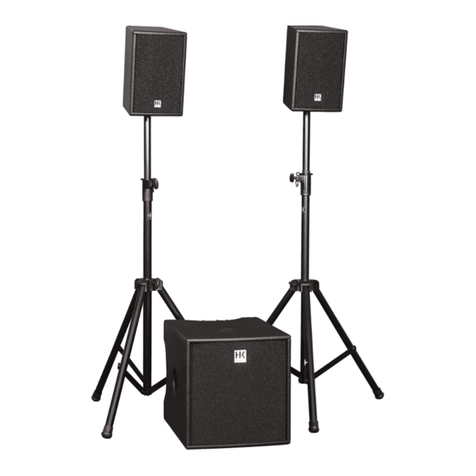
HK Audio
HK Audio L.U.C.A.S PERFORMER Technical manual
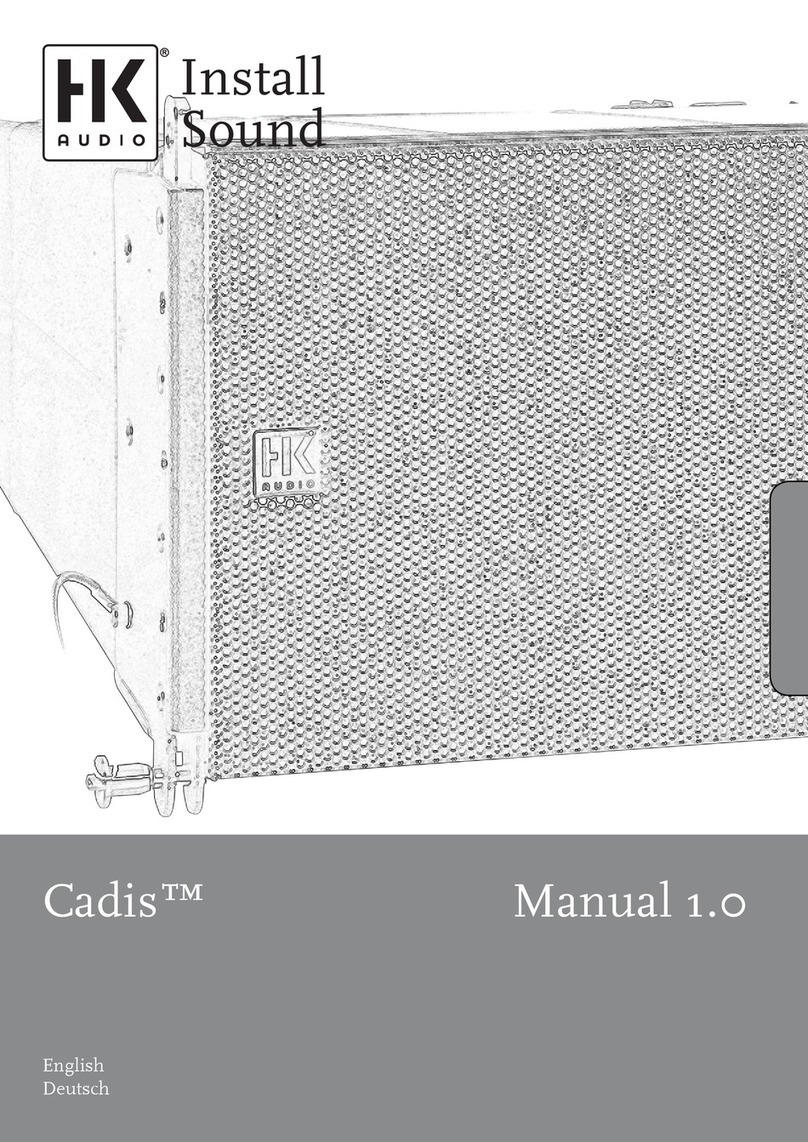
HK Audio
HK Audio Cadis CAD 208 User manual
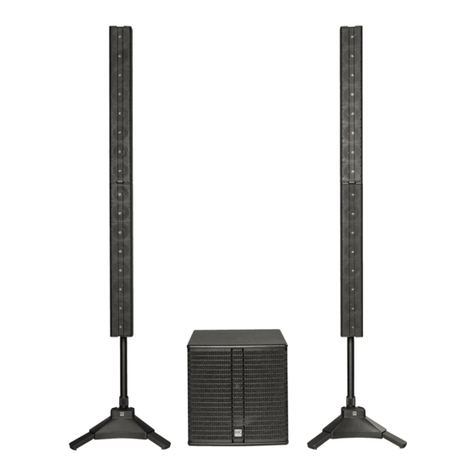
HK Audio
HK Audio ELEMENTS GALA User manual
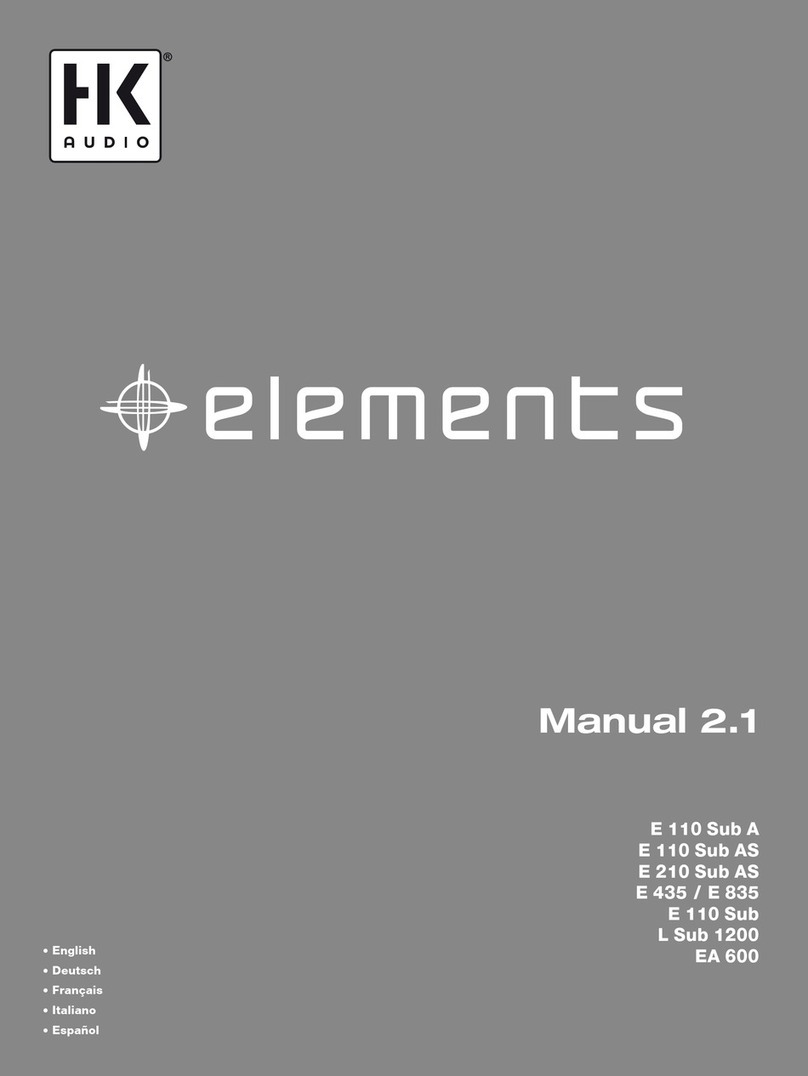
HK Audio
HK Audio elements E 110 Sub A User manual

HK Audio
HK Audio POLAR 8 User manual
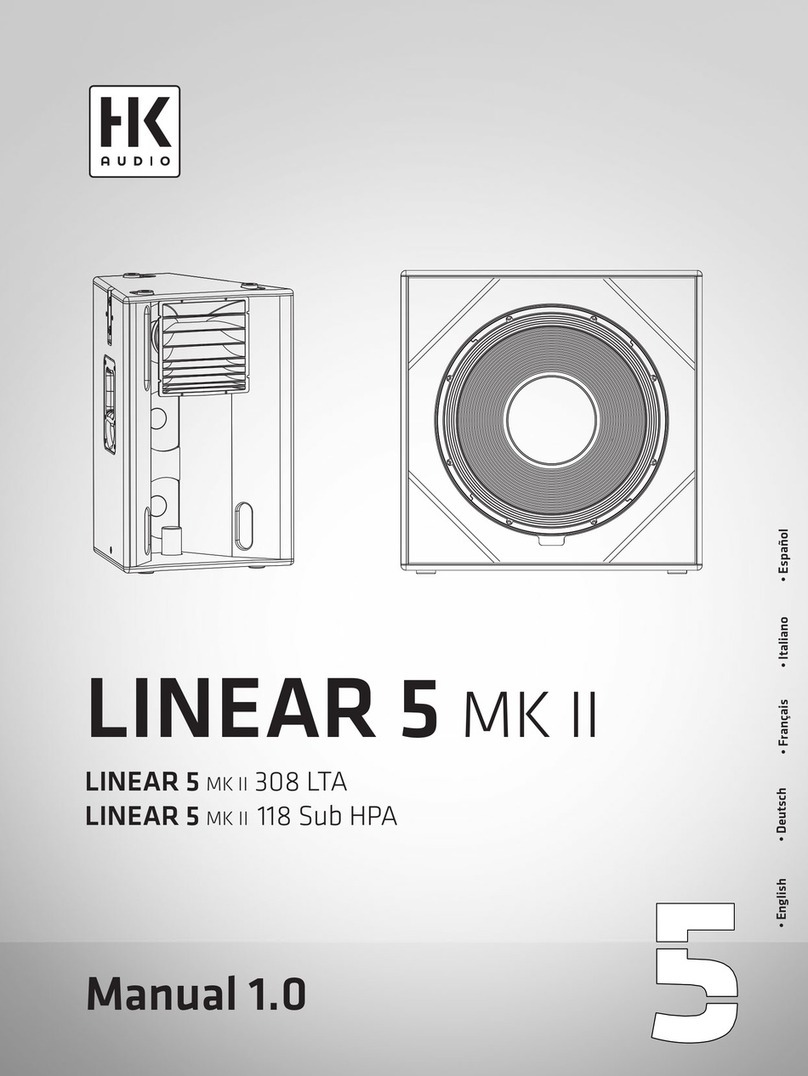
HK Audio
HK Audio LINEAR 5 MK II 308 LTA User manual
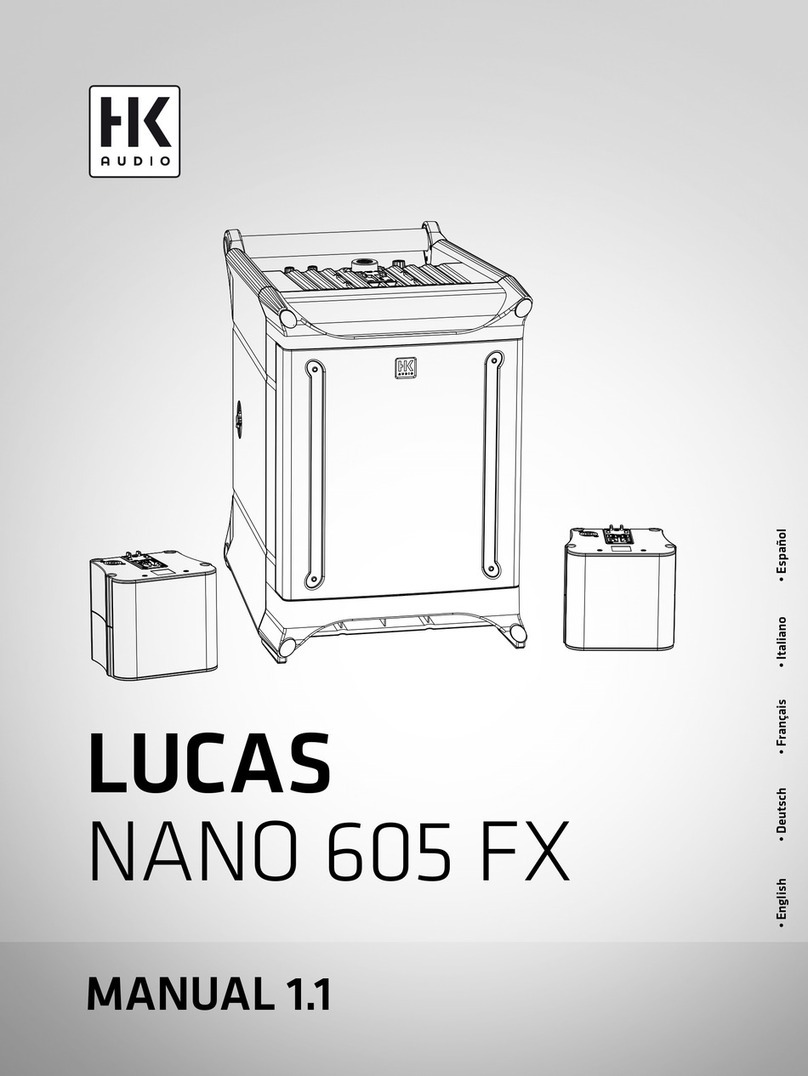
HK Audio
HK Audio LUCAS NANO 605 FX User manual
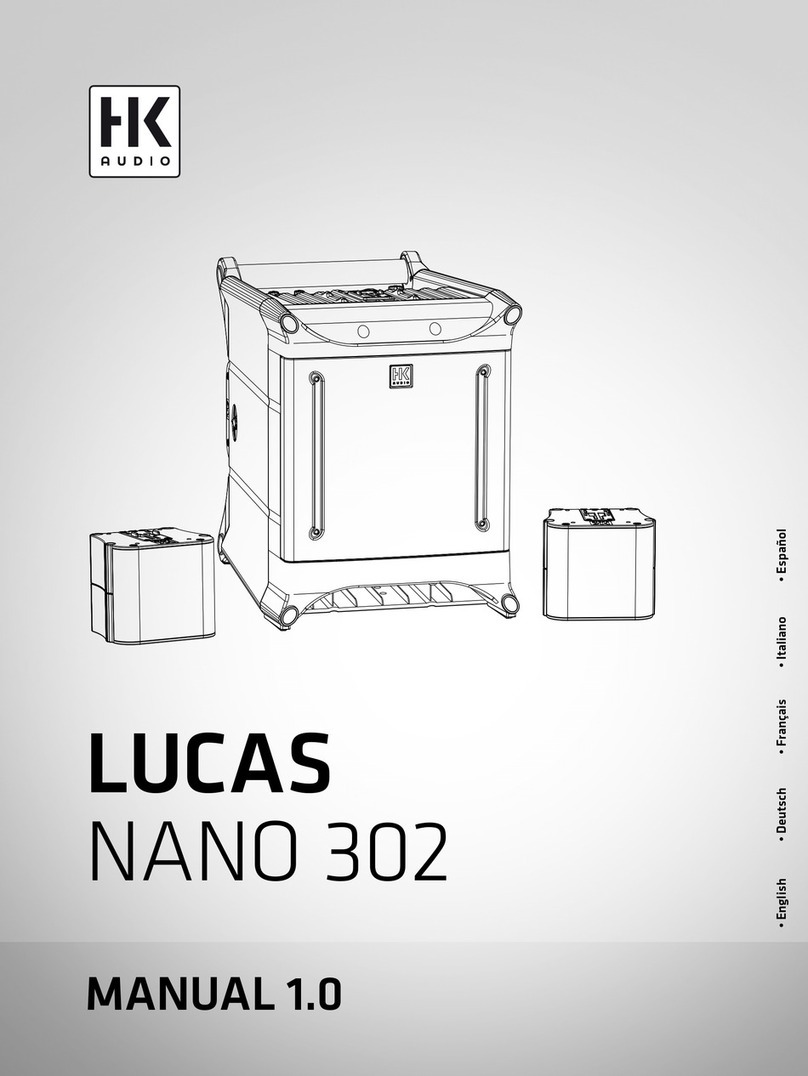
HK Audio
HK Audio LUCAS NANO 302 User manual
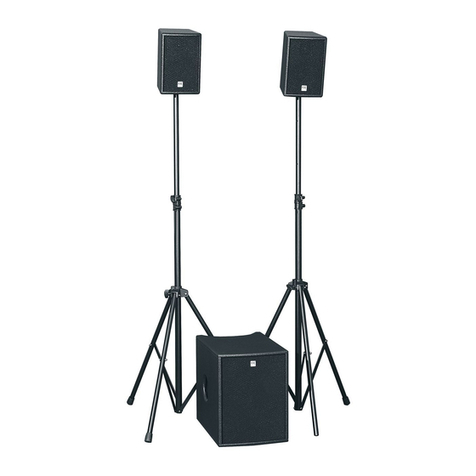
HK Audio
HK Audio LUCAS XT User manual
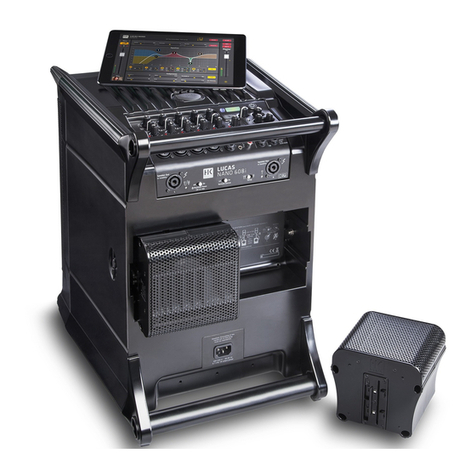
HK Audio
HK Audio lucas nano 608i User manual
